UNITED STATES
SECURITIES AND EXCHANGE COMMISSION
Washington, D.C. 20549
FORM 6-K
REPORT OF FOREIGN PRIVATE ISSUER PURSUANT TO RULE 13a-16 OR 15d-16 UNDER THE SECURITIES EXCHANGE ACT OF 1934
March 21, 2024
Commission File Number: 001-39363
IMMATICS N.V.
Paul-Ehrlich-Straße 15
72076 Tübingen, Federal Republic of Germany
(Address of principal executive office)
Indicate by check mark whether the registrant files or will file annual reports under cover of Form 20-F or Form 40-F:
| Form 20-F |
☒ |
Form 40-F |
☐ |
INFORMATION CONTAINED IN THIS REPORT ON FORM 6-K
On March 21, 2024, Immatics N.V. (the “Company”) issued a press release announcing its full year 2023 financial results and providing certain corporate updates. A copy of the press release is attached hereto as Exhibit 99.1. In addition, the Company made available an updated investor presentation. A copy of the presentation is attached hereto as Exhibit 99.2. The fact that the presentation is being made available and furnished herewith is not an admission as to the materiality of any information contained in the presentation. The information contained in the presentation is being provided as of March 21, 2024 and the Company does not undertake any obligation to update the presentation in the future or to update forward-looking statements to reflect subsequent actual results.
EXHIBIT INDEX
| Exhibit No. | Description |
| 99.1 | Press release dated March 21, 2024 |
| 99.2 | Corporate presentation dated March 2024 |
SIGNATURES
Pursuant to the requirements of the Securities Exchange Act of 1934, the registrant has duly caused this report to be signed on its behalf by the undersigned, thereunto duly authorized.
| IMMATICS N.V. | ||
| Date: March 21, 2024 | ||
| By: | /s/ Harpreet Singh | |
| Name: | Harpreet Singh | |
| Title: | Chief Executive Officer | |
Exhibit 99.1

Immatics Announces Full Year 2023 Financial Results
and Corporate Update
| · | Interim clinical data update on ACTengine® IMA203 GEN1 (PRAME) in melanoma at RP2D in November 2023: 50% confirmed objective response rate with median duration of response not reached at median follow-up of 14.4 months; IMA203 was well tolerated |
| · | Registration-enabling randomized Phase 2/3 trial for ACTengine® IMA203 GEN1 in 2L+ melanoma planned to begin in 2024 |
| · | Next data update on IMA203 GEN1 and IMA203CD8 GEN2 planned for 2H 2024 |
| · | First clinical data updates for Immatics’ next-generation TCR Bispecifics, TCER® IMA401 (MAGEA4/8) and TCER® IMA402 (PRAME), from ongoing Phase 1 dose escalation trials planned for 2H 2024; updates to include details on safety, pharmacokinetics and initial anti-tumor activity |
| · | In May 2023, Bristol Myers Squibb exercised first opt-in into the autologous cell therapy collaboration ($15 million option fee received) and made a $35 million equity investment in July 2023 |
| · | In September 2023, Immatics and Moderna announced a strategic multi-platform collaboration to develop innovative oncology therapeutics; Immatics received $120 million upfront payment, and the total deal volume could exceed $1.7 billion |
| · | $201.5 million public offering completed on January 22, 2024 |
| · | Cash and cash equivalents as well as other financial assets amount to $470.6 million1 (€425.9 million) as of December 31, 2023. Addition of proceeds from the public offering in January 2024 results in projected cash runway into 2027 |
Houston, Texas and Tuebingen, Germany, March 21, 2024 – Immatics N.V. (NASDAQ: IMTX, “Immatics”), a clinical-stage biopharmaceutical company active in the discovery and development of T cell-redirecting cancer immunotherapies, today provided a business update and reported financial results for the quarter and full year ended December 31, 2023.
“Immatics kicked off 2024 with a successful capital raise, providing significant financial runway and additional momentum to advance our ongoing clinical cell therapy and bispecific trials,” said Harpreet Singh, Ph.D., CEO and Co-Founder of Immatics. “We are striving to reach multiple relevant milestones this year, including announcing clinical proof-of-concept for our half-life
1 All amounts translated using the exchange rate published by the European Central Bank in effect as of December 31, 2023 (1 EUR = 1.105 USD).
| Immatics Press Release March 21, 2024 |
|
extended TCR Bispecifics platform. In parallel, the clinical data for our PRAME cell therapy, IMA203 GEN1, in conjunction with highly constructive FDA discussions, reinforces our confidence in advancing this asset toward a registration-enabling Phase 2/3 clinical trial in melanoma, while laying the groundwork to transition into a fully equipped commercial-stage company.”
Full Year 2023 and Subsequent Company Progress
ACTengine® IMA203 (PRAME)
Clinical development plan update for ACTengine® IMA203 GEN1 and IMA203CD8 GEN2 monotherapies
Following an RMAT designation in October 2023 and productive interactions with the FDA, Immatics plans to initiate a registration-enabling randomized Phase 2/3 trial in 2024 for IMA203 GEN1 in patients with second-line or later (2L+) cutaneous melanoma, potentially including also uveal melanoma patients.
Immatics intends to assess IMA203 GEN1 targeting PRAME in HLA-A*02:01-positive cutaneous melanoma patients versus a control arm. This single trial will be designed to support accelerated approval based on an interim readout and full approval based on overall survival. The high prevalence of PRAME (≥95%) in cutaneous melanoma may enable the company to enroll patients without PRAME pre-testing. This would enhance trial operations and could remove the need to develop a companion diagnostic in this indication. The full trial design is currently being developed and is subject to further alignment with the FDA as part of the ongoing discussions. The Phase 2/3 trial is planned to start in 2024.
For IMA203CD8 GEN2, Immatics cleared dose level 4a (DL4a, up to ~1.6x109 TCR-T cells) in December 2023, which is currently intended to be the target dose for further development. In addition to treating melanoma patients, Immatics has also started to expand its clinical footprint outside of melanoma to address a broader patient population with a particular focus on ovarian and uterine cancers.
A next data update for both Phase 1b cohorts with IMA203 GEN1 and IMA203CD8 GEN2 is planned for 2H 2024.
Manufacturing capabilities
| Immatics Press Release March 21, 2024 |
|
Immatics’ late-stage clinical cell therapy development is supported by its streamlined manufacturing timeline, capabilities and facility. IMA203 GEN1 and IMA203CD8 GEN2 cell therapy products are manufactured within 7 days followed by a 7-day QC release testing at a success rate of >95% to reach the target dose (IMA203 GEN1: RP2D; IMA203CD8: DL4a). The company has also recently completed construction of a ~100,000 square foot R&D and GMP manufacturing facility with a modular design for efficient and cost-effective scalability to serve early-stage and registration-enabling clinical trials, as well as potential initial commercial supply.
Interim clinical data update on ACTengine® IMA203 GEN1 and IMA203CD8 GEN2 monotherapies, as of November 2023
On November 8, 2023, Immatics provided an interim clinical update from the ongoing Phase 1 trial with ACTengine® IMA203 targeting PRAME in patients with recurrent and/or refractory solid cancers (data cut-off September 30, 2023). The update was focused on IMA203 GEN1 in melanoma patients at the recommended Phase 2 dose (RP2D, 1.0-10x109 total TCR-T cells) and the first clinical data for IMA203CD8 GEN2.
Treatment with IMA203 GEN1 monotherapy (consisting of PRAME-specific functional CD8+ cells) in Phase 1a and Phase 1b Cohort A at RP2D demonstrated durable objective responses in melanoma patients with one patient exceeding 12 months and two patients exceeding 15 months post infusion and a 50% (6/12) confirmed objective response rate (cORR). Median duration of response (mDOR) was not reached (min 2.2+ months, max 14.7+ months) at a median follow-up (mFU) of 14.4 months. In line with previous results, IMA203 GEN1 monotherapy was well tolerated at total doses of up to 10x109 TCR-T cells infused.
In addition, the first data on the company’s second-generation product candidate IMA203CD8 (consisting of PRAME-specific functional CD8+ and CD4+ cells) demonstrated 56% (5/9) cORR with enhanced pharmacology compared to IMA203 GEN1. mDOR was not reached (min 2.0+ months, max 11.5+ months) at a mFU of 4.8 months. As of the reported cut-off date, IMA203CD8 GEN2 exhibited a manageable tolerability profile.
TCR Bispecifics Programs
Immatics’ T cell engaging receptor (TCER®) candidates are next-generation, half-life extended TCR Bispecific molecules. They are designed to achieve a patient-convenient dosing schedule and to maximize efficacy while minimizing toxicities in patients through the proprietary format using a high-affinity TCR domain against the tumor target and a low-affinity T cell recruiter binding to the T cell.
| Immatics Press Release March 21, 2024 |
|
Upcoming milestones for Immatics’ clinical TCER® pipeline
Immatics seeks to deliver clinical proof-of-concept for its novel TCER® platform as quickly as possible and plans to provide first clinical data for IMA401 (MAGEA4/8) and IMA402 (PRAME) in 2H 2024.
Key objectives include:
| · | Demonstrating tolerability of the novel, next-generation, half-life extended TCR Bispecifics format; |
| · | Optimizing dosing schedule to a less frequent regimen already during dose escalation, based on pharmacokinetics data; |
| · | Demonstrating initial clinical anti-tumor activity (i.e., confirmed objective responses according to RECIST 1.1). |
| · | TCER® IMA401 (MAGEA4/8) – The Phase 1 trial to evaluate safety, tolerability and initial anti-tumor activity of TCER® IMA401 in patients with recurrent and/or refractory solid tumors is ongoing. IMA401 targets an HLA-A*02:01-presented peptide that occurs identically in two different proteins, MAGEA4 and MAGEA8. This target peptide has been selected based on natural expression in native solid tumors at particularly high target density (peptide copy number per tumor cell identified by Immatics’ proprietary quantitative mass spectrometry engine XPRESIDENT®). MAGEA4 and MAGEA8 are expressed in multiple solid cancers including lung cancer, head and neck cancer, melanoma, ovarian cancer, sarcoma and others. IMA401 is being developed in collaboration with Bristol Myers Squibb. First clinical data in at least 25 patients in dose escalation across multiple solid cancers is expected to be announced in 2H 2024. |
| · | TCER® IMA402 (PRAME) – Immatics initiated the Phase 1/2 trial investigating the company’s fully owned TCER® candidate IMA402 in patients with recurrent and/or refractory solid tumors in August 2023 and the first patients have been dosed. Initial focus indications are ovarian cancer, lung cancer, uterine cancer, and cutaneous and uveal melanoma, among others. IMA402 targets an HLA-A*02:01-presented peptide derived from the tumor antigen PRAME. This target peptide has been selected based on natural expression in native solid primary tumors and metastases at particularly high target density (peptide copy number per tumor cell identified by Immatics’ proprietary quantitative mass spectrometry engine XPRESIDENT®). Immatics has recently engaged with a CDMO for the manufacturing of clinical IMA402 batches for its use within a potential registration-enabling trial. Patient recruitment and dose escalation continue to scale. First clinical data in at least 15 patients in dose |
| Immatics Press Release March 21, 2024 |
|
escalation across multiple solid cancers, but initially focused on melanoma, is anticipated to be announced in 2H 2024.
Corporate Development
| · | On January 22, 2024, Immatics completed an offering of 18,313,750 ordinary shares at a public offering price of $11.00 per share. The gross proceeds from the offering, before deducting the underwriting discount and offering expenses, were approximately $201.5 million. |
| · | In January 2024, Immatics hired Jason Braun as Senior Vice President Commercial to support the company as it transitions into a fully equipped commercial-stage entity and targets the initiation of a registration-enabling Phase 2/3 trial for its PRAME TCR-T cell therapy. Jason Braun joins the company with more than 20 years of experience in the biotech and pharma industry, having worked with several biopharmaceutical companies including Amgen, Dendreon, Pharmacyclics (Abbvie), Kite (Gilead) and Nkarta, among others. During his career, he has established a successful track record in the commercialization of oncology drug candidates. |
| · | On September 11, 2023, Immatics announced a strategic multi-platform collaboration with Moderna, combining Immatics’ target and TCR platforms with Moderna’s cutting-edge mRNA technology. The collaboration spans various therapeutic modalities including bispecifics, cell therapy and cancer vaccines. Under the terms of the agreement, Immatics received an upfront payment of $120 million. In addition, Immatics will receive research funding and is eligible to receive development, regulatory and commercial milestone payments that could exceed $1.7 billion. |
| · | On July 24, 2023, Bristol Myers Squibb made a $35 million equity investment in Immatics, purchasing 2,419,818 ordinary shares in a private placement transaction at a subscription price per share of $14.46. |
| · | In May 2023, Bristol Myers Squibb exercised its first option and entered into a global license agreement with Immatics for the most advanced TCR-T product candidate. As part of the agreement, Immatics received an option payment of $15 million and is eligible for up to $490 million in milestone payments in addition to tiered royalties on net sales of the product. |
Full Year 2023 Financial Results
Cash Position: Cash and cash equivalents as well as other financial assets total €425.9 million ($470.6 million1) as of December 31, 2023, compared to €362.2 million ($400.2 million1) as of December 31, 2022. The increase is mainly due to upfront payments for collaborations, partly offset by our ongoing research and development activities. This does not include the net
| Immatics Press Release March 21, 2024 |
|
proceeds received in January 2024 from the public offering. Adding these proceeds, the company currently projects a cash runway into 2027.
Revenue: Total revenue, consisting of revenue from collaboration agreements, was €54.0 million ($59.7 million1) for the year ended December 31, 2023, compared to €172.8 million ($190.9 million1) for the year ended December 31, 2022. The decrease is mainly the result of a one-time revenue for the license portion of the IMA401 collaboration with Bristol Myers Squibb for the year ended December 31, 2022.
Research and Development Expenses: R&D expenses were €118.7 million ($131.2 million1) for the year ended December 31, 2023, compared to €106.8 million ($118.0 million1) for the year ended December 31, 2022. The increase mainly resulted from costs associated with the advancement of the clinical pipeline of ACTengine® and TCER® candidates.
General and Administrative Expenses: G&A expenses were €38.2 million ($42.2 million1) for the year ended December 31, 2023, compared to €36.1 million ($39.9 million1) for the year ended December 31, 2022.
Net Profit and Loss: Net loss was €97.0 million ($107.2 million1) for the year ended December 31, 2023, compared to a net profit of €37.5 million ($41.4 million1) for the year ended December 31, 2022. The decrease of net profit resulted mainly from the one-time license fee income in connection with the IMA401 collaboration with Bristol Myers Squibb, as well as the recognition of remaining deferred revenue in connection with the termination of the GSK collaboration for the year ended December 31, 2022.
Full financial statements can be found in the Annual Report on Form 20-F filed with the Securities and Exchange Commission (SEC) and published on the SEC website under www.sec.gov.
Upcoming Investor Conferences
| · | Bank of America Health Care Conference, Las Vegas (NV) – May 14 - 16, 2024 |
| · | Jefferies Global Healthcare Conference, New York (NY) – June 5 - 7, 2024 |
To see the full list of events and presentations, visit www.investors.immatics.com/events-presentations.
| Immatics Press Release March 21, 2024 |
|
About Immatics
Immatics combines the discovery of true targets for cancer immunotherapies with the development of the right T cell receptors with the goal of enabling a robust and specific T cell response against these targets. This deep know-how is the foundation for our pipeline of Adoptive Cell Therapies and TCR Bispecifics as well as our partnerships with global leaders in the pharmaceutical industry. We are committed to delivering the power of T cells and to unlocking new avenues for patients in their fight against cancer.
Immatics intends to use its website www.immatics.com as a means of disclosing material non-public information. For regular updates you can also follow us on X, Instagram and LinkedIn.
Forward-Looking Statements
Certain statements in this press release may be considered forward-looking statements. Forward-looking statements generally relate to future events or the Company’s future financial or operating performance. For example, statements concerning timing of data read-outs for product candidates, the timing and outcome of clinical trials, the nature of clinical trials (including whether such clinical trials will be registration-enabling), the timing of IND or CTA filing for pre-clinical stage product candidates, estimated market opportunities of product candidates, the Company’s focus on partnerships to advance its strategy, and other metrics are forward-looking statements. In some cases, you can identify forward-looking statements by terminology such as “may”, “should”, “expect”, “plan”, “target”, “intend”, “will”, “estimate”, “anticipate”, “believe”, “predict”, “potential” or “continue”, or the negatives of these terms or variations of them or similar terminology. Such forward-looking statements are subject to risks, uncertainties, and other factors which could cause actual results to differ materially from those expressed or implied by such forward looking statements. These forward-looking statements are based upon estimates and assumptions that, while considered reasonable, Immatics and its management, are inherently uncertain. New risks and uncertainties may emerge from time to time, and it is not possible to predict all risks and uncertainties. Factors that may cause actual results to differ materially from current expectations include, but are not limited to, various factors beyond management's control including general economic conditions and other risks, uncertainties and factors set forth in the Company’s Annual report on Form 20-F and other filings with the Securities and Exchange Commission (SEC). Nothing in this press release should be regarded as a representation by any person that the forward-looking statements set forth herein will be achieved or that any of the contemplated results of such forward-looking statements will be achieved. You should not place undue reliance on forward-looking statements, which speak only as of the date they are made. The Company undertakes no duty to update these forward-looking statements. All the scientific and clinical data presented within this press release are – by definition prior to completion of the clinical trial and a clinical study report – preliminary in nature and subject to further quality checks including customary source data verification.
| Immatics Press Release March 21, 2024 |
|
For more information, please contact:
| Media | |
| Trophic Communications | |
| Phone: +49 171 3512733 | |
| immatics@trophic.eu |
| Immatics N.V. | |
| Sabrina Schecher, Ph.D. | |
| Senior Director, Investor Relations | |
| Phone: +1 346 319-3325 | |
| InvestorRelations@immatics.com |
| Immatics Press Release March 21, 2024 |
|
Immatics N.V. and subsidiaries
Condensed Consolidated Statement of Profit/(Loss) of Immatics N.V.
Year ended December 31, |
||||||||||||
2023 |
2022 |
2021 |
||||||||||
| (Euros in thousands, except per share data) | ||||||||||||
| Revenue from collaboration agreements | 53,997 | 172,831 | 34,763 | |||||||||
| Research and development expenses | (118,663 | ) | (106,779 | ) | (87,574 | ) | ||||||
| General and administrative expenses | (38,198 | ) | (36,124 | ) | (33,808 | ) | ||||||
| Other income | 1,139 | 26 | 325 | |||||||||
| Operating result | (101,725 | ) | 29,954 | (86,294 | ) | |||||||
| Change in fair value of liabilities for warrants | (2,079 | ) | 10,945 | (10,990 | ) | |||||||
| Other financial income | 13,850 | 9,416 | 5,675 | |||||||||
| Other financial expenses | (7,040 | ) | (8,279 | ) | (1,726 | ) | ||||||
| Financial result | 4,731 | 12,082 | (7,041 | ) | ||||||||
| Profit/(loss) before taxes | (96,994 | ) | 42,036 | (93,335 | ) | |||||||
| Taxes on income | — | (4,522 | ) | — | ||||||||
| Net profit/(loss) | (96,994 | ) | 37,514 | (93,335 | ) | |||||||
| Net profit/(loss) per share: | ||||||||||||
| Basic | (1.20 | ) | 0.56 | (1.48 | ) | |||||||
| Diluted | (1.20 | ) | 0.55 | (1.48 | ) | |||||||
| Immatics Press Release March 21, 2024 |
|
Immatics N.V. and subsidiaries
Condensed Consolidated Statement of Comprehensive Loss of Immatics N.V.
Year ended December 31, |
||||||||||||
2023 |
2022 |
2021 |
||||||||||
| (Euros in thousands) | ||||||||||||
| Net profit/(loss) | (96,994 | ) | 37,514 | (93,335 | ) | |||||||
| Other comprehensive income/(loss) | ||||||||||||
| Items that may be reclassified subsequently to profit or loss | ||||||||||||
| Currency translation differences from foreign operations | (155 | ) | 2,464 | 3,514 | ||||||||
| Total comprehensive income/(loss) for the year | (97,149 | ) | 39,978 | (89,821 | ) | |||||||
| Immatics Press Release March 21, 2024 |
|
Immatics N.V. and subsidiaries
Condensed Consolidated Statement of Financial Position of Immatics N.V.
As of |
||||||||
December 31, 2023 |
December 31, 2022 |
|||||||
| (Euros in thousands) | ||||||||
| Assets | ||||||||
| Current assets | ||||||||
| Cash and cash equivalents | 218,472 | 148,519 | ||||||
| Other financial assets | 207,423 | 213,686 | ||||||
| Accounts receivables | 4,093 | 1,111 | ||||||
| Other current assets | 19,382 | 13,838 | ||||||
| Total current assets | 449,370 | 377,154 | ||||||
| Non-current assets | ||||||||
| Property, plant and equipment | 43,747 | 13,456 | ||||||
| Intangible assets | 1,523 | 1,632 | ||||||
| Right-of-use assets | 13,308 | 13,033 | ||||||
| Other non-current assets | 2,017 | 2,545 | ||||||
| Total non-current assets | 60,595 | 30,666 | ||||||
| Total assets | 509,965 | 407,820 | ||||||
| Liabilities and shareholders’ equity | ||||||||
| Current liabilities | ||||||||
| Accounts payables | 25,206 | 13,056 | ||||||
| Deferred revenue | 100,401 | 64,957 | ||||||
| Liabilities for warrants | 18,993 | 16,914 | ||||||
| Lease liabilities | 2,604 | 2,159 | ||||||
| Other current liabilities | 9,348 | 9,366 | ||||||
| Total current liabilities | 156,552 | 106,452 | ||||||
| Non-current liabilities | ||||||||
| Deferred revenue | 115,527 | 75,759 | ||||||
| Lease liabilities | 12,798 | 12,403 | ||||||
| Other non-current liabilities | 4 | 42 | ||||||
| Total non-current liabilities | 128,329 | 88,204 | ||||||
| Shareholders’ equity | ||||||||
| Share capital | 847 | 767 | ||||||
| Share premium | 823,166 | 714,177 | ||||||
| Accumulated deficit | (597,293 | ) | (500,299 | ) | ||||
| Other reserves | (1,636 | ) | (1,481 | ) | ||||
| Total shareholders’ equity | 225,084 | 213,164 | ||||||
| Total liabilities and shareholders’ equity | 509,965 | 407,820 | ||||||
| Immatics Press Release March 21, 2024 |
|
Immatics N.V. and subsidiaries
Condensed Consolidated Statement of Cash Flows of Immatics N.V.
Year ended December 31, |
||||||||||||
2023 |
2022 |
2021 |
||||||||||
| (Euros in thousands) | ||||||||||||
| Cash flows from operating activities | ||||||||||||
| Net profit/(loss) | (96,994 | ) | 37,514 | (93,335 | ) | |||||||
| Taxes on income | — | 4,522 | — | |||||||||
| Profit/(loss) before tax | (96,994 | ) | 42,036 | (93,335 | ) | |||||||
| Adjustments for: | ||||||||||||
| Interest income | (13,845 | ) | (2,476 | ) | (133 | ) | ||||||
| Depreciation and amortization | 7,234 | 6,967 | 5,260 | |||||||||
| Interest expenses | 831 | 1,038 | 566 | |||||||||
| Equity-settled share-based payment | 20,705 | 22,570 | 26,403 | |||||||||
| Net foreign exchange differences and expected credit losses | 6,861 | 2,953 | (2,408 | ) | ||||||||
| Change in fair value of liabilities for warrants | 2,079 | (10,945 | ) | 10,990 | ||||||||
| (Gains)/losses from disposal of fixed assets | (150 | ) | — | — | ||||||||
| Changes in: | ||||||||||||
| (Increase)/decrease in accounts receivables | (2,982 | ) | (429 | ) | 569 | |||||||
| Decrease/(Increase) in other assets | (1,387 | ) | (7,872 | ) | (483 | ) | ||||||
| Increase/(decrease) in deferred revenue, accounts payables and other liabilities | 85,999 | 45,559 | (31,784 | ) | ||||||||
| Interest received | 10,167 | 1,649 | 175 | |||||||||
| Interest paid | (290 | ) | (695 | ) | (566 | ) | ||||||
| Income tax paid | — | (224 | ) | — | ||||||||
| Net cash provided by/(used in) operating activities | 18,228 | 100,131 | (84,746 | ) | ||||||||
| Cash flows from investing activities | ||||||||||||
| Payments for property, plant and equipment | (30,799 | ) | (5,738 | ) | (5,106 | ) | ||||||
| Payments for intangible assets | (158 | ) | (477 | ) | (551 | ) | ||||||
| Proceeds from disposal of property, plant and equipment | 150 | 52 | — | |||||||||
| Payments for investments classified in Other financial assets | (415,325 | ) | (216,323 | ) | (11,298 | ) | ||||||
| Proceeds from maturity of investments classified in Other financial assets | 414,744 | 12,695 | 24,448 | |||||||||
| Net cash (used in)/provided by investing activities | (31,388 | ) | (209,791 | ) | 7,493 | |||||||
| Cash flows from financing activities | ||||||||||||
| Proceeds from issuance of shares to equity holders | 90,404 | 134,484 | 94 | |||||||||
| Transaction costs deducted from equity | (2,039 | ) | (7,931 | ) | — | |||||||
| Repayment of lease liabilities | (3,849 | ) | (2,843 | ) | (2,707 | ) | ||||||
| Net cash provided by/(used in) financing activities | 84,516 | 123,710 | (2,613 | ) | ||||||||
| Net increase/(decrease) in cash and cash equivalents | 71,356 | 14,050 | (79,866 | ) | ||||||||
| Cash and cash equivalents at beginning of the year | 148,519 | 132,994 | 207,530 | |||||||||
| Effects of exchange rate changes and expected credit losses on cash and cash equivalents | (1,403 | ) | 1,475 | 5,330 | ||||||||
| Cash and cash equivalents at end of the year | 218,472 | 148,519 | 132,994 | |||||||||
| Immatics Press Release March 21, 2024 |
|
Immatics N.V. and subsidiaries
Condensed Consolidated Statement of Changes in Shareholders’ equity (deficit) of Immatics N.V.
(Euros in thousands) |
Share |
Share |
Accumulated |
Other |
Total |
|||||||||||||||
| Balance as of January 1, 2021 | 629 | 538,695 | (444,478 | ) | (7,459 | ) | 87,387 | |||||||||||||
| Other comprehensive income | — | — | — | 3,514 | 3,514 | |||||||||||||||
| Net loss | — | — | (93,335 | ) | — | (93,335 | ) | |||||||||||||
| Comprehensive loss for the year | — | — | (93,335 | ) | 3,514 | (89,821 | ) | |||||||||||||
| Equity-settled share-based compensation | — | 26,403 | — | — | 26,403 | |||||||||||||||
| Share options exercised | — | 94 | — | — | 94 | |||||||||||||||
| Balance as of December 31, 2021 | 629 | 565,192 | (537,813 | ) | (3,945 | ) | 24,063 | |||||||||||||
| Balance as of January 1, 2022 | 629 | 565,192 | (537,813 | ) | (3,945 | ) | 24,063 | |||||||||||||
| Other comprehensive income | — | — | — | 2,464 | 2,464 | |||||||||||||||
| Net profit | — | — | 37,514 | — | 37,514 | |||||||||||||||
| Comprehensive income for the year | — | — | 37,514 | 2,464 | 39,978 | |||||||||||||||
| Equity-settled share-based compensation | — | 22,570 | — | — | 22,570 | |||||||||||||||
| Share options exercised | — | 311 | — | — | 311 | |||||||||||||||
| Issue of share capital – net of transaction costs | 138 | 126,104 | — | — | 126,242 | |||||||||||||||
| Balance as of December 31, 2022 | 767 | 714,177 | (500,299 | ) | (1,481 | ) | 213,164 | |||||||||||||
| Balance as of January 1, 2023 | 767 | 714,177 | (500,299 | ) | (1,481 | ) | 213,164 | |||||||||||||
| Other comprehensive loss | — | — | — | (155 | ) | (155 | ) | |||||||||||||
| Net loss | — | — | (96,994 | ) | — | (96,994 | ) | |||||||||||||
| Comprehensive loss for the year | — | — | (96,994 | ) | (155 | ) | (97,149 | ) | ||||||||||||
| Equity-settled share-based compensation | — | 20,705 | — | — | 20,705 | |||||||||||||||
| Share options exercised | — | 139 | — | — | 139 | |||||||||||||||
| Issue of share capital – net of transaction costs | 80 | 88,145 | — | — | 88,225 | |||||||||||||||
| Balance as of December 31, 2023 | 847 | 823,166 | (597,293 | ) | (1,636 | ) | 225,084 | |||||||||||||
| Immatics Press Release March 21, 2024 |
|
Exhibit 99.2

© Immatics. Not for further reproduction or distribution. Delivering the Power of T cells to Cancer Patients © Immatics. Not for further reproduction or distribution.
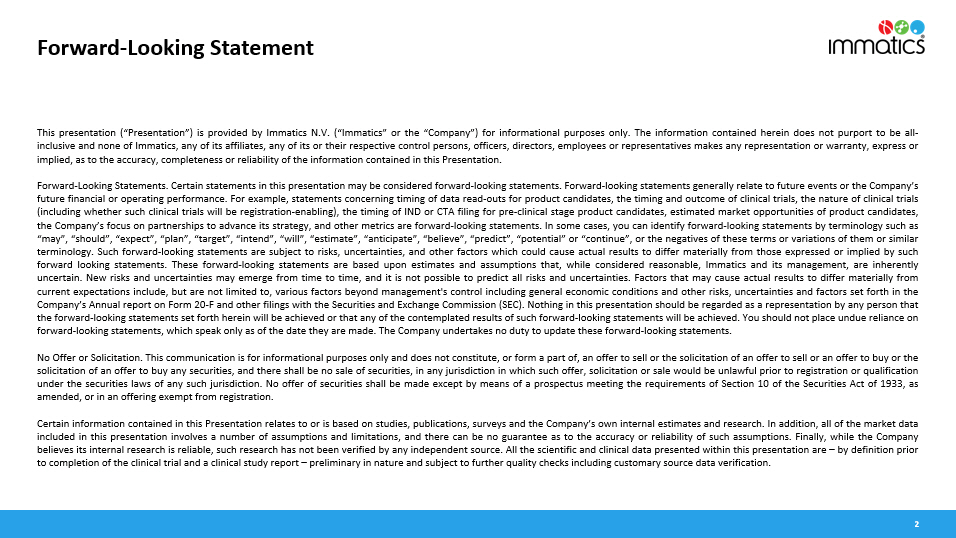
Immatics Corporate Presentation March 21, 2024 Forward - Looking Statement This presentation (“Presentation”) is provided by Immatics N . V . (“Immatics” or the “Company”) for informational purposes only . The information contained herein does not purport to be all - inclusive and none of Immatics, any of its affiliates, any of its or their respective control persons, officers, directors, employees or representatives makes any representation or warranty, express or implied, as to the accuracy, completeness or reliability of the information contained in this Presentation . Forward - Looking Statements . Certain statements in this presentation may be considered forward - looking statements . Forward - looking statements generally relate to future events or the Company’s future financial or operating performance . For example, statements concerning timing of data read - outs for product candidates, the timing and outcome of clinical trials, the nature of clinical trials (including whether such clinical trials will be registration - enabling), the timing of IND or CTA filing for pre - clinical stage product candidates, estimated market opportunities of product candidates, the Company’s focus on partnerships to advance its strategy, and other metrics are forward - looking statements . In some cases, you can identify forward - looking statements by terminology such as “may”, “should”, “expect”, “plan”, “target”, “intend”, “will”, “estimate”, “anticipate”, “believe”, “predict”, “potential” or “continue”, or the negatives of these terms or variations of them or similar terminology . Such forward - looking statements are subject to risks, uncertainties, and other factors which could cause actual results to differ materially from those expressed or implied by such forward looking statements . These forward - looking statements are based upon estimates and assumptions that, while considered reasonable, Immatics and its management, are inherently uncertain . New risks and uncertainties may emerge from time to time, and it is not possible to predict all risks and uncertainties . Factors that may cause actual results to differ materially from current expectations include, but are not limited to, various factors beyond management's control including general economic conditions and other risks, uncertainties and factors set forth in the Company’s Annual report on Form 20 - F and other filings with the Securities and Exchange Commission (SEC) . Nothing in this presentation should be regarded as a representation by any person that the forward - looking statements set forth herein will be achieved or that any of the contemplated results of such forward - looking statements will be achieved . You should not place undue reliance on forward - looking statements, which speak only as of the date they are made . The Company undertakes no duty to update these forward - looking statements . No Offer or Solicitation . This communication is for informational purposes only and does not constitute, or form a part of, an offer to sell or the solicitation of an offer to sell or an offer to buy or the solicitation of an offer to buy any securities, and there shall be no sale of securities, in any jurisdiction in which such offer, solicitation or sale would be unlawful prior to registration or qualification under the securities laws of any such jurisdiction . No offer of securities shall be made except by means of a prospectus meeting the requirements of Section 10 of the Securities Act of 1933 , as amended, or in an offering exempt from registration . Certain information contained in this Presentation relates to or is based on studies, publications, surveys and the Company’s own internal estimates and research . In addition, all of the market data included in this presentation involves a number of assumptions and limitations, and there can be no guarantee as to the accuracy or reliability of such assumptions . Finally, while the Company believes its internal research is reliable, such research has not been verified by any independent source . All the scientific and clinical data presented within this presentation are – by definition prior to completion of the clinical trial and a clinical study report – preliminary in nature and subject to further quality checks including customary source data verification . 2 Therapeutic Opportunity Potential for addressing large patient populations with high prevalence targets in solid tumors Two Clinical - Stage Modalities Pipeline of TCR - T and TCR Bispecific product candidates in clinical & preclinical development Building a Leading TCR Therapeutics Company 3 Intro Differentiated Platforms Unique technologies to identify true cancer targets and right TCRs Clinical PoC for Cell Therapy Anti - tumor activity and durability of response across multiple solid tumors in early TCR - T clinical development

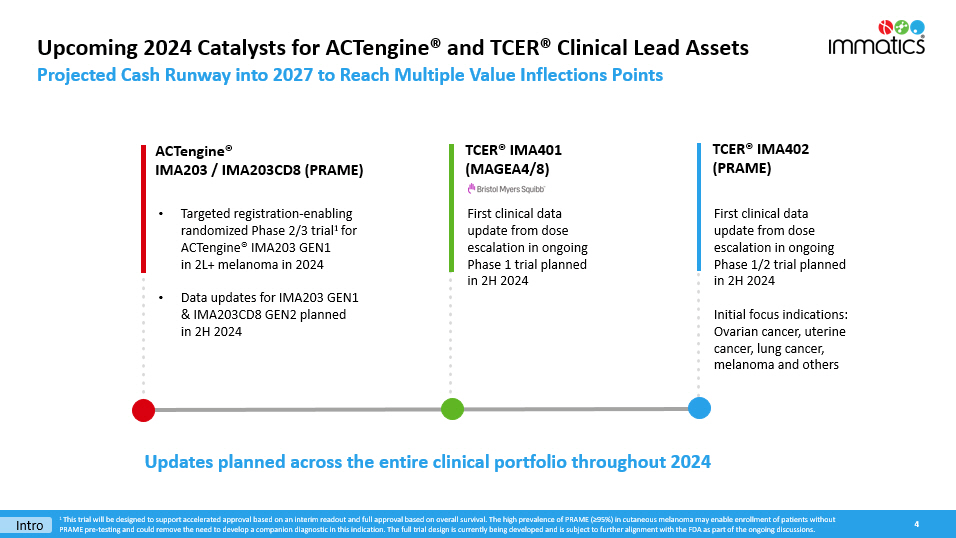
Upcoming 2024 Catalysts for ACTengine® and TCER® Clinical Lead Assets Projected Cash Runway into 2027 to Reach Multiple Value Inflections Points 4 • Targeted registration - enabling randomized Phase 2/3 trial 1 for ACTengine ® IMA203 GEN1 in 2L+ melanoma in 2024 • Data updates for IMA203 GEN1 & IMA203CD8 GEN2 planned in 2H 2024 ACTengine® IMA203 / IMA203CD8 (PRAME) First clinical data update from dose escalation in ongoing Phase 1 trial planned in 2H 2024 TCER® IMA401 (MAGEA4/8) First clinical data update from dose escalation in ongoing Phase 1/2 trial planned in 2H 2024 Initial focus indications: Ovarian cancer, uterine cancer, lung cancer, melanoma and others TCER® IMA402 (PRAME) Updates planned across the entire clinical portfolio throughout 2024 Intro 1 This trial will be designed to support accelerated approval based on an interim readout and full approval based on overall su rvi val. The high prevalence of PRAME (≥95%) in cutaneous melanoma may enable enroll ment of patients without PRAME pre - testing and could remove the need to develop a companion diagnostic in this indication. The full trial design is curre ntly being developed and is subject to further alignment with the FDA as part of the ongoing discussions.

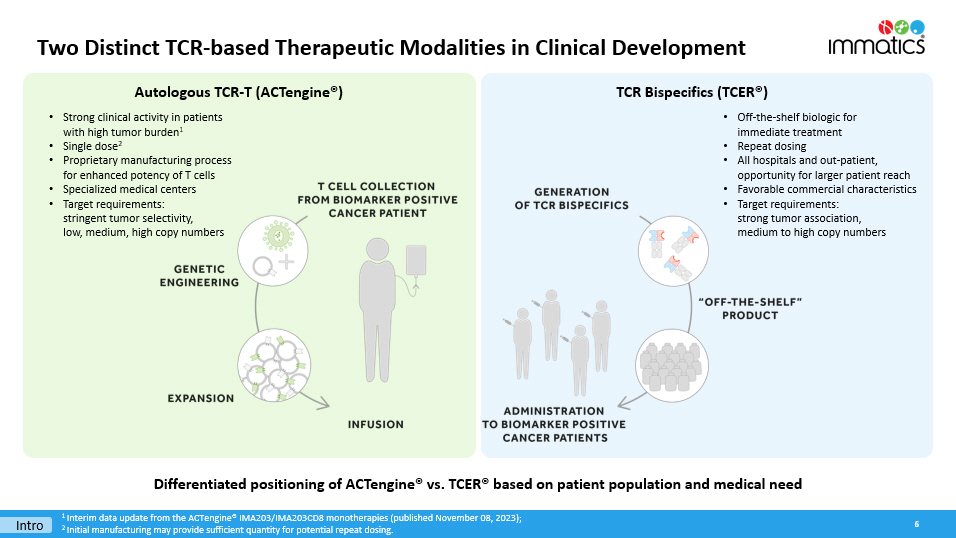
Our TCR - based Approaches Leverage the Full Target Space beyond the Cancer Cell Surface 5 Intro Two Distinct TCR - based Therapeutic Modalities in Clinical Development 6 Differentiated positioning of ACTengine® vs. TCER® based on patient population and medical need Intro 1 Interim data update from the ACTengine® IMA203/IMA203CD8 monotherapies (published November 08, 2023); 2 Initial manufacturing may provide sufficient quantity for potential repeat dosing. Autologous TCR - T (ACTengine®) TCR Bispecifics (TCER®) • Strong clinical activity in patients with high tumor burden 1 • Single dose 2 • Proprietary manufacturing process for enhanced potency of T cells • Specialized medical centers • Target requirements: stringent tumor selectivity, low, medium, high copy numbers • Off - the - shelf biologic for immediate treatment • Repeat dosing • All hospitals and out - patient, opportunity for larger patient reach • Favorable commercial characteristics • Target requirements: strong tumor association, medium to high copy numbers Modality Product Candidate Target Preclinical Phase 1a 1 Phase 1b 1 Phase 2 Phase 3 Autologous ACT ACTengine® IMA203 PRAME ACTengine® IMA203CD8 PRAME ACTengine® IMA204 COL6A3 Multiple programs Undisclosed Allogeneic ACT γδ T cells ACTallo® IMA30x Undisclosed Multiple programs Undisclosed Bispecifics TCER® IMA401 MAGEA4/8 TCER® IMA402 PRAME TCER® IMA40x Undisclosed Multiple programs 3 Undisclosed Our Pipeline of TCR - based Adoptive Cell Therapies and Bispecifics 7 Intro 1 Phase 1a: Dose escalation, Phase 1b: Dose expansion ; 2 I mmatics ’ proprietary ACTallo® platform utilizing Editas’ CRISPR gene editing technology; 3 mRNA - enabled in vivo expressed TCER® molecules 2
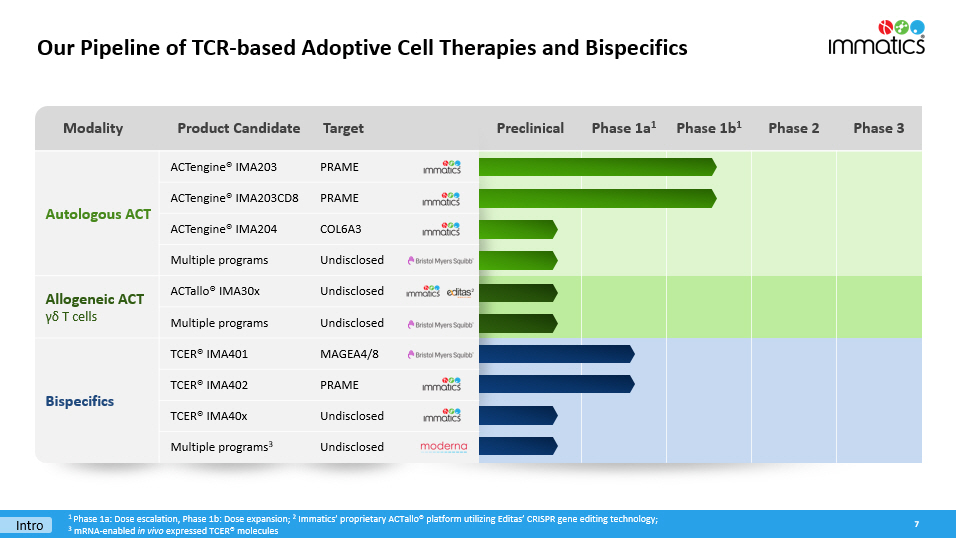

Potential for Large Patient Populations across Multiple Solid Cancers 8 Uterine Carcinoma – 97 % Uterine Carcinosarcoma – 100% Sarcoma Subtypes – up to 100% Cut. Melanoma ≥ 95% Uveal Melanoma 1 ≥ 91% Ovarian Carcinoma – 84% Squamous NSCLC – 68% TNBC – 63% Small Cell Lung Cancer – 45% Kidney Carcinoma – up to 40% Cholangiocarcinoma – 33% HNSCC – 27% Esophageal Carcinoma – 27% Breast Carcinoma – 26% Adeno NSCLC – 25% HCC – 18 % Bladder Carcinoma – 18% Squamous NSCLC – 52% Sarcoma Subtypes – up to 60% HNSCC – 36% Bladder Carcinoma – 29 % Uterine Carcinosarcoma – 29% Esophageal Carcinoma – 23% Ovarian Carcinoma – 23% Melanoma – 18 % I MA203 / IMA402 PRAME IMA401 MAGEA4/8 IMA204 COL6A3 Exon 6 Intro ACTengine® and TCER® targets demonstrate high prevalence in m ultiple s olid cancers Target prevalence for selected solid cancer indications are based on TCGA (for SCLC: in - house) RNAseq data combined with a propr ietary mass spec - guided RNA expression threshold ; 1 Uveal melanoma target prevalence is based on IMADetect® qPCR testing of screening biopsies from clinical trial patients (n=33 ) Pancreatic Carcinoma – 76% Breast Carcinoma – 77% Stomach Carcinoma – 67% Sarcoma – 63% Colorectal Carcinoma – 60% Esophageal Carcinoma – 60% Squamous NSCLC – 55% Adeno NSCLC – 57% HNSCC – 56% Uterine Carcinosarcoma – 50% Mesothelioma – 44% Cholangiocarcinoma – 36% Melanoma – 35% Bladder Carcinoma – 34% Ovarian Carcinoma – 31% Realizing the Full Multi - Cancer Opportunity of PRAME ACTengine® IMA203 (TCR - T) and TCER® IMA402 (TCR Bispecific) 9 ACTengine® IMA203 (TCR - T) Cancer Cell Death PRAME is one of the most promising and most prevalent, clinically validated solid tumor targets known to date Leverage the full potential of targeting PRAME by continued evaluation of the best suited therapeutic modality (ACTengine® vs. TCER® or both) for each cancer type Intro Phase 1b dose expansion ongoing TCER® IMA402 (TCR Bispecific) 1 PRAME target prevalence is based on TCGA (for SCLC: in - house) RNAseq data combined with a proprietary mass spec - guided RNA expre ssion threshold; 2 Uveal melanoma target prevalence is based on IMADetect® qPCR testing of screening biopsies from clinical trial patients (n=33); NSCLC: Non - small cell lung cancer, TNBC: Triple - negative breast cancer, HNSCC: Head and neck squamous cell carcinoma; HCC: Hepatocellular carcinoma Indication % PRAME positive patients 1 Uterine Carcinoma Uterine Carcinosarcoma Sarcoma Subtypes Cut. Melanoma Uveal Melanoma 2 Ovarian Carcinoma Squamous NSCLC TNBC Small Cell Lung Cancer Kidney Carcinoma Cholangiocarcinoma HNSCC Esophageal Carcinoma Breast Carcinoma Adeno NSCLC HCC Bladder Carcinoma 97% 100% up to 100% ≥ 95% ≥ 91% 84% 68% 63% 45% up to 40% 33% 27% 27% 26% 25% 18% 18% Dose escalation of Phase 1/2 trial ongoing
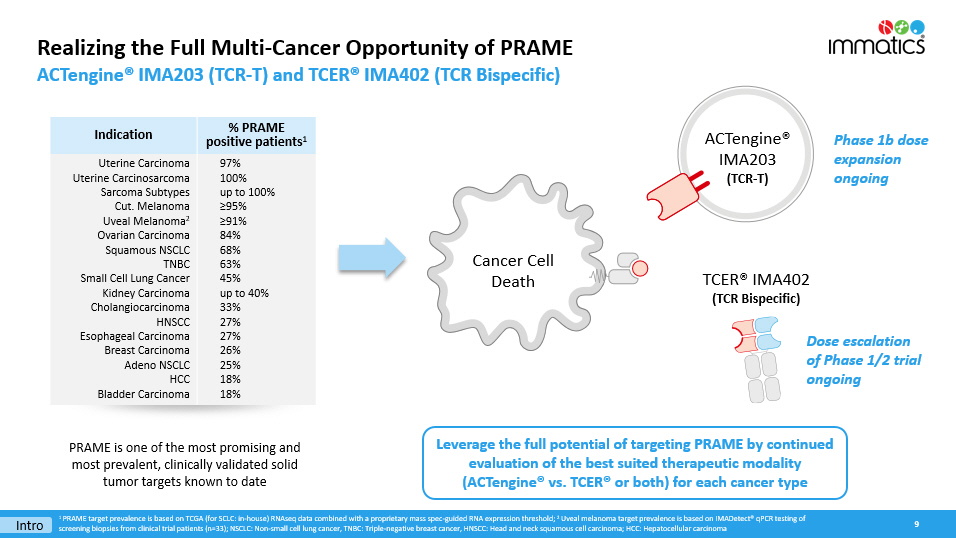

ACTengine® IMA203 – TCR - T Targeting PRAME 10
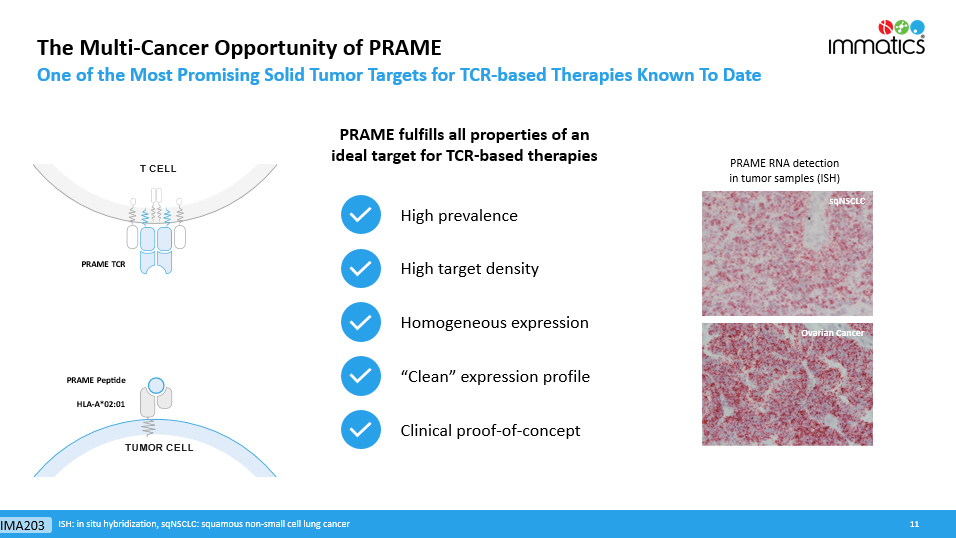
The Multi - Cancer Opportunity of PRAME One of the Most Promising Solid Tumor Targets for TCR - based Therapies Known To Date 11 High prevalence High target density Homogeneous expression “Clean” expression profile Clinical proof - of - concept s qNSCLC Ovarian Cancer PRAME fulfills all properties of an ideal target for TCR - based therapies PRAME RNA detection in tumor samples (ISH) ISH: in situ hybridization, sqNSCLC : squamous n on - small cell lung cancer IMA203 78025&(// 7&(// ,> Ͳ Ύ ϬϮ ͗ Ϭϭ WZD d Z WZD W Ğ Ɖ ƟĚĞ ACTengine® IMA203 Targeting PRAME – Mechanism of Action Immatics’ Leading TCR - T Approach 12 IMA203 LEUKAPHARESIS

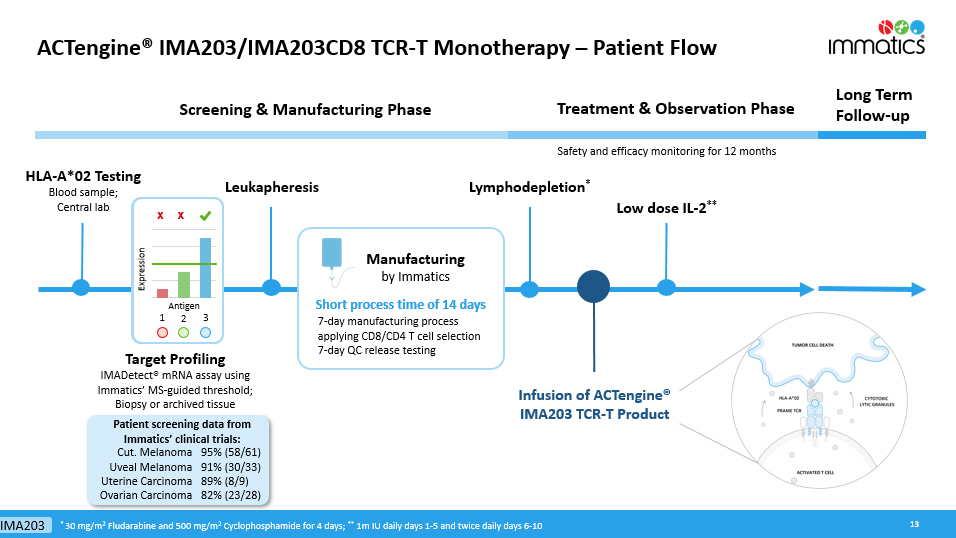
ACTengine® IMA203/IMA203CD8 TCR - T Monotherapy – Patient Flow 13 HLA - A*02 Testing Blood sample; Central lab Treatment & Observation Phase Long Term Follow - up Screening & Manufacturing Phase Manufacturing by Immatics Infusion of ACTengine® IMA203 TCR - T Product Lymphodepletion * Target Profiling IMADetect ® mRNA assay using Immatics’ MS - guided threshold; Biopsy or archived tissue Low dose IL - 2 ** Safety and efficacy monitoring for 12 months Leukapheresis x x Expression Antigen 1 3 2 Short process time of 14 days * 30 mg/m 2 Flu darabine and 500 mg/m 2 Cy clophosphamide for 4 days; ** 1m IU daily days 1 - 5 and twice daily days 6 - 10 7 - day manufacturing process applying CD8/CD4 T cell selection 7 - day QC release testing Cut.

Melanoma Uveal Melanoma Uterine Carcinoma Ovarian Carcinoma 95% (58/61) 91% (30/33) 89% (8/9) 82% (23/28) Patient screening data from Immatics’ clinical trials: IMA203 IMA203 GEN1 – Melanoma as First Indication for Pivotal Development 14 * Patients with at least one post treatment tumor response assessment Patient characteristics All comers Cohort A Melanoma pts Ph1a & Cohort A at RP2D Ovarian cancer pts Ph1a & Cohort A at RP2D Efficacy population* 18 13 4 Prior lines of treatment Median (min, max) 3 (0, 10) 4 (0, 7) 4.5 (3, 10) LDH at baseline >1 x ULN [% of patients] 50.0 53.9 100.0 Baseline tumor burden Target lesion sum of diameter [mm] (median, min, max) 58.9 (21.0, 207.3) 52.0 (21.0, 178.7) 108.8 (50.6, 207.3) Patient Numbers* ALL Melanoma Ovarian Cancer Synovial Sarcoma H&N Cancer Others Phase 1a RP2D 7 5 0 0 0 2 Cohort A RP2D 18 8 4 3 1 2 All 8 cut.

melanoma patients were CPI - refractory and 5 of 8 were BRAF - inhibitor pretreated • Sub - group analysis per tumor type at target dose includes data from Phase 1a plus Cohort A at RP2D • Melanoma patient number (N=13) and characteristics allow such sub - group analysis for initial assessment of anti - tumor activity • For other tumor types, appropriate patient numbers and characteristics have not yet been achieved All ovarian cancer patients were platinum - resistant Data cut - off Sep 30, 2023 IMA203 ACTengine® IMA203 / IMA203CD8 TCR - T Trial in Advanced Solid Tumors Overview Phase 1a Dose Escalation : Dose Level 1 - 4 (total N=27) 7 patients in DL4 treated at RP2D Efficacy population shown: patients treated with IMA203 (Cohort A) or IMA203CD8 (Cohort C) and with at least one available tu mor response assessment post infusion; RP2D: Recommended Phase 2 Dose of 1 - 10x10 9 total TCR - T cells; IMA203 DL4: 0.2 - 1.2x10 9 TCR - T cells/m 2 BSA, IMA203 DL5: 1.201 x 4.7x10 9 TCR - T cells/m 2 BSA; IMA203CD8 DL3: 0.2 - 0.48x10 9 TCR - T cells/m 2 BSA, IMA203CD8 DL4a: 0.481 - 0.8x10 9 TCR - T cells/m 2 BSA, IMA203CD8 DL4b: 0.801 - 1.2x10 9 TCR - T cells/m 2 ; 1 DL4a cleared in Dec 2023 Data cut - off Sep 30, 2023 GEN1 : IMA203 GEN2 : IMA203CD8 Functional CD8 TCR - T cells only Functional CD8 and CD4 TCR - T cells Melanoma Patients at RP2D: Total N=13 Phase 1b Dose Expansion Cohort C (N=12): Dose Level 3/4a/4b; DL4a cleared as currently intended target dose 1 Phase 1b Dose Expansion Cohort A: Dose Level 4/5 (total N=18) All 18 patients treated at RP2D 15 RP2D defined at 1 - 10x10 9 TCR - T cell Phase 1a and Cohort A data set in appendix IMA203 Overview of Patient Characteristics and Responses 16 * Patients with at least one available tumor response assessment post infusion; # All patients were PD at data cut - off; Initial ORR: Objective response rate according to RECIST 1.1 at any post infusion scan; Confirmed ORR ( cORR ): Confirmed objective response rate according to RECIST 1.1 for patients with at least two available post infusion scans or patients with progressi ve disease (PD) at any prior timepoint, patients with ongoing unconfirmed PR not included in cORR calculation; Duration of response (DOR) in confirmed responders is defined as time from first documented response until disease progression/death.

Pat ien ts with ongoing response will be censored at date of data cut - off. Median DOR is analyzed by using the Kaplan - Meier method; Median Follow - up is analyzed by using the reverse Kaplan - Meier method; DOR: Duration of Response; FU: Follow - up IMA203 GEN1 IMA203CD8 GEN2 All Comers (N=45) Melanoma Subgroup (N=13 of 45) All Comers (N=12) Phase 1a Cohort A Phase 1a + Cohort A Cohort C Efficacy population* N=27 Thereof N=7 at RP2D N=18 at RP2D N=13 at RP2D N=12 Prior lines of systemic treatment ( median, min, max) 4 (1, 8) 3 (0, 10) 4 (0, 7) 3 (1, 5) LDH at baseline >1 x ULN [% of patients] 66.7 50.0 53.8 50.0 Baseline tumor burden Median target lesion sum of diameter [mm] (min, max) 133.0 (29, 219.7) 58.9 (21, 207.3) 52.0 (21.0, 178.7) 79.8 (20.0, 182.0) Dose level DL1 - 4 DL4/5 DL4/5 DL3/DL4a/DL4b ORR 48% (13/27) 50% (9/18) 62% (8/13) 58% (7/12) cORR 19% (5/27) 47% (8/17) 50% (6/12) 56% (5/9) mDOR [months] 4.4 (2.4, 23.0) Not reached Not reached Not reached mFU [months] Not defined # 10.8 14.4 4.8 Data cut - off Sep 30, 2023 Heavily Pretreated Patient Population across Clinical Trial Cohorts IMA203 ACTengine® IMA203 TCR - T Interim Update Delivering a Meaningful Benefit to Patients with an Unmet Medical Need 17 IMA203 GEN1 Monotherapy Phase 1a & Cohort A – Focus on Melanoma at RP2D IMA203CD8 GEN2 Monotherapy Cohort C – First Data Set on 2 nd Generation Summary & Next Development Steps IMA203
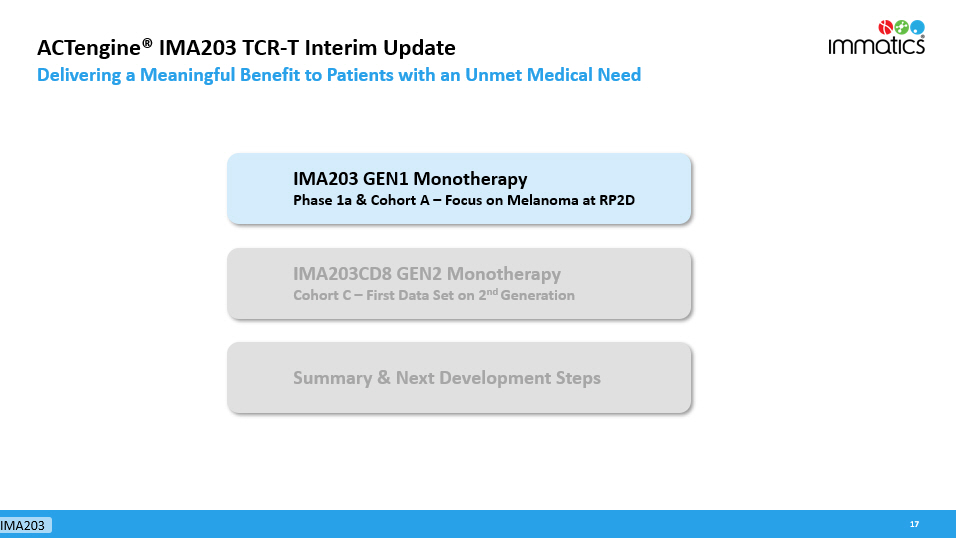
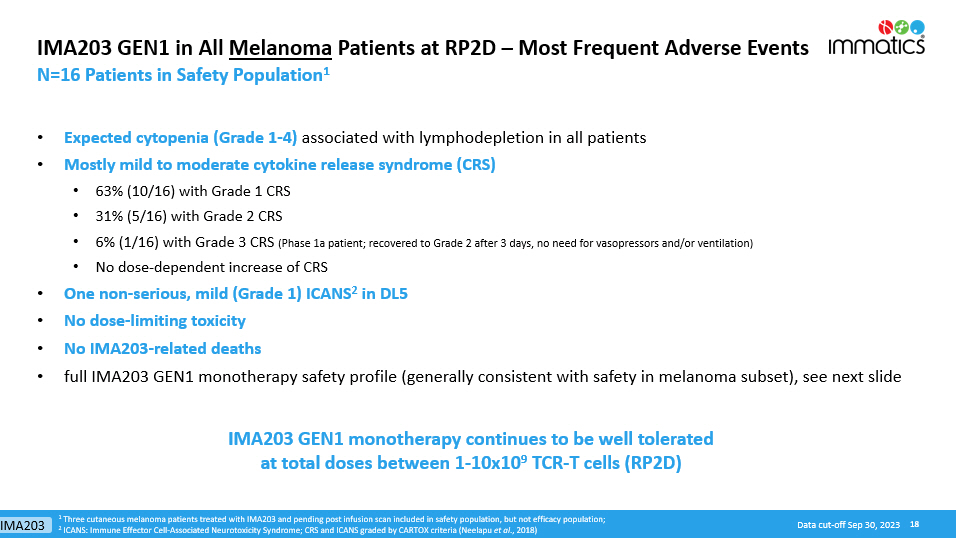
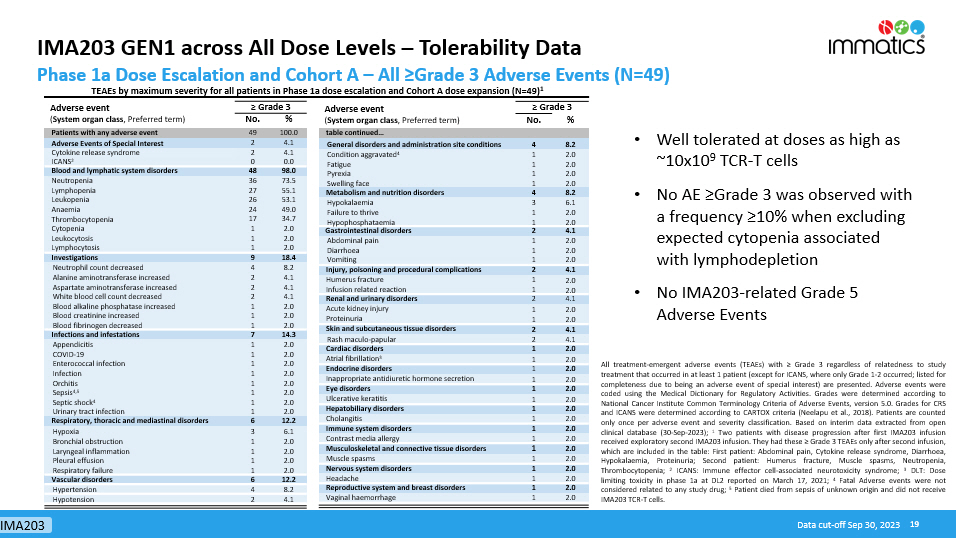
18 Data cut - off Sep 30, 2023 IMA203 GEN1 in All Melanoma Patients at RP2D – Most Frequent Adverse Events • Expected cytopenia (Grade 1 - 4) associated with lymphodepletion in all patients • Mostly mild to moderate cytokine release syndrome (CRS) • 63% (10/16) with Grade 1 CRS • 31% (5/16) with Grade 2 CRS • 6% (1/16) with Grade 3 CRS (Phase 1a patient; recovered to Grade 2 after 3 days, no need for vasopressors and/or ventilation) • No dose - dependent increase of CRS • O ne non - serious, mild (Grade 1) ICANS 2 in DL5 • No dose - limiting toxicity • No IMA203 - related deaths • full IMA203 GEN1 monotherapy safety profile (generally consistent with safety in melanoma subset), see next slide 1 Three cutaneous melanoma patients treated with IMA203 and pending post infusion scan included in safety population, but not e ff icacy population; 2 I CANS: Immune Effector Cell - Associated N eurotoxicity S yndrome ; CRS and ICANS graded by CARTOX criteria ( Neelapu et al ., 2018) N=16 Patients in Safety Population 1 IMA203 GEN1 monotherapy continues to be well tolerated at total doses between 1 - 10x10 9 TCR - T cells (RP2D) IMA203 Adverse event ( System organ class , Preferred term ) ≥ Grade 3 No . % Patients with any adverse event 49 100.0 Adverse Events of Special Interest 2 4.1 Cytokine release syndrome 2 4.1 ICANS 2 0 0.0 Blood and lymphatic system disorders 48 98.0 Neutropenia 36 73.5 Lymphopenia 27 55.1 Leukopenia 26 53.1 Anaemia 24 49.0 Thrombocytopenia 17 34.7 Cytopenia 1 2.0 Leukocytosis 1 2.0 Lymphocytosis 1 2.0 Investigations 9 18.4 Neutrophil count decreased 4 8.2 Alanine aminotransferase increased 2 4.1 Aspartate aminotransferase increased 2 4.1 White blood cell count decreased 2 4.1 Blood alkaline phosphatase increased 1 2.0 Blood creatinine increased 1 2.0 Blood fibrinogen decreased 1 2.0 Infections and infestations 7 14.3 Appendicitis 1 2.0 COVID - 19 1 2.0 Enterococcal infection 1 2.0 Infection 1 2.0 Orchitis 1 2.0 Sepsis 4,5 1 2.0 Septic shock 4 1 2.0 Urinary tract infection 1 2.0 Respiratory, thoracic and mediastinal disorders 6 12.2 Hypoxia 3 6.1 Bronchial obstruction 1 2.0 Laryngeal inflammation 1 2.0 Pleural effusion 1 2.0 Respiratory failure 1 2.0 Vascular disorders 6 12.2 Hypertension 4 8.2 Hypotension 2 4.1 Adverse event ( System organ class , Preferred term ) ≥ Grade 3 No . % table continued… General disorders and administration site conditions 4 8.2 Condition aggravated 4 1 2.0 Fatigue 1 2.0 Pyrexia 1 2.0 Swelling face 1 2.0 Metabolism and nutrition disorders 4 8.2 Hypokalaemia 3 6.1 Failure to thrive 1 2.0 Hypophosphataemia 1 2.0 Gastrointestinal disorders 2 4.1 Abdominal pain 1 2.0 Diarrhoea 1 2.0 Vomiting 1 2.0 Injury, poisoning and procedural complications 2 4.1 Humerus fracture 1 2.0 Infusion related reaction 1 2.0 Renal and urinary disorders 2 4.1 Acute kidney injury 1 2.0 Proteinuria 1 2.0 Skin and subcutaneous tissue disorders 2 4.1 Rash maculo - papular 2 4.1 Cardiac disorders 1 2.0 Atrial fibrillation 3 1 2.0 Endocrine disorders 1 2.0 Inappropriate antidiuretic hormone secretion 1 2.0 Eye disorders 1 2.0 Ulcerative keratitis 1 2.0 Hepatobiliary disorders 1 2.0 Cholangitis 1 2.0 Immune system disorders 1 2.0 Contrast media allergy 1 2.0 Musculoskeletal and connective tissue disorders 1 2.0 Muscle spasms 1 2.0 Nervous system disorders 1 2.0 Headache 1 2.0 Reproductive system and breast disorders 1 2.0 Vaginal haemorrhage 1 2.0 IMA203 GEN1 across All Dose Levels – Tolerability Data Phase 1a Dose Escalation and Cohort A – All ≥Grade 3 Adverse Events (N=49) 19 • Well tolerated at doses as high as ~10x10 9 TCR - T cells • No AE ≥Grade 3 was observed with a frequency ≥10% when excluding expected cytopenia associated with lymphodepletion • No IMA203 - related Grade 5 Adverse Events All treatment - emergent adverse events (TEAEs) with ≥ Grade 3 regardless of relatedness to study treatment that occurred in at least 1 patient (except for ICANS, where only Grade 1 - 2 occurred ; listed for completeness due to being an adverse event of special interest) are presented . Adverse events were coded using the Medical Dictionary for Regulatory Activities . Grades were determined according to National Cancer Institute Common Terminology Criteria of Adverse Events, version 5 . 0 . Grades for CRS and ICANS were determined according to CARTOX criteria ( Neelapu et al . , 2018 ) . Patients are counted only once per adverse event and severity classification . Based on interim data extracted from open clinical database ( 30 - Sep - 2023 ) ; 1 Two patients with disease progression after first IMA 203 infusion received exploratory second IMA 203 infusion . They had these ≥ Grade 3 TEAEs only after second infusion, which are included in the table : First patient : Abdominal pain, Cytokine release syndrome, Diarrhoea , Hypokalaemia , Proteinuria ; Second patient : Humerus fracture, Muscle spasms, Neutropenia, Thrombocytopenia ; 2 ICANS : Immune effector cell - associated neurotoxicity syndrome ; 3 DLT : Dose limiting toxicity in phase 1 a at DL 2 reported on March 17 , 2021 ; 4 Fatal Adverse events were not considered related to any study drug ; 5 Patient died from sepsis of unknown origin and did not receive IMA 203 TCR - T cells .
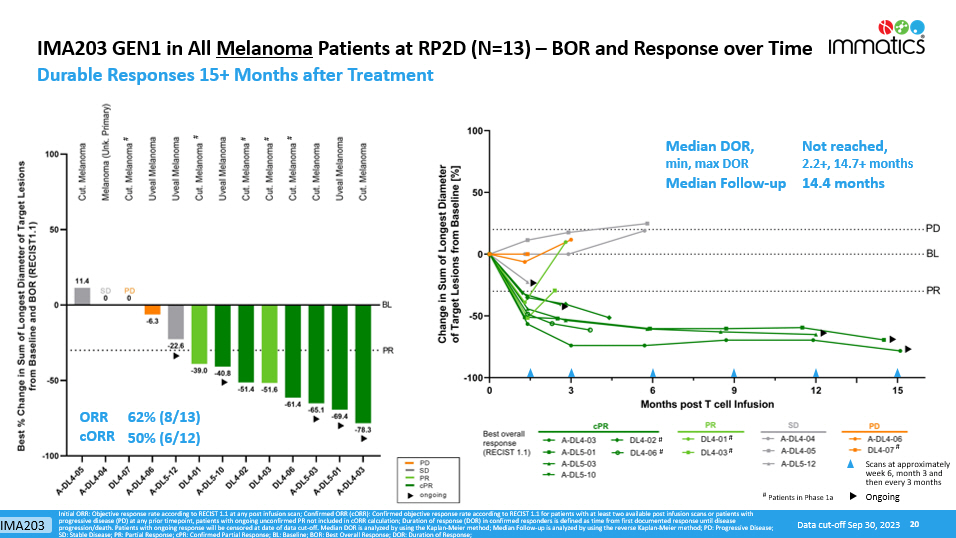
TEAEs by maximum severity for all patients in Phase 1a dose escalation and Cohort A dose expansion (N=49) 1 Data cut - off Sep 30, 2023 IMA203 # # # # # # # # # # IMA203 GEN1 in All Melanoma Patients at RP2D (N=13) – BOR and Response over Time Durable Responses 15+ Months after Treatment 20 Data cut - off Sep 30, 2023 Ongoing ORR 62% (8/13) cORR 50% (6/12) Initial ORR: Objective response rate according to RECIST 1.1 at any post infusion scan; Confirmed ORR ( cORR ): Confirmed objective response rate according to RECIST 1.1 for patients with at least two available post infusion scans or pat ients with progressive disease (PD) at any prior timepoint, patients with ongoing unconfirmed PR not included in cORR calculation; Duration of response (DOR) in confirmed responders is defined as time from first documented response until disease progression/death. Patients with ongoing response will be censored at date of data cut - off.
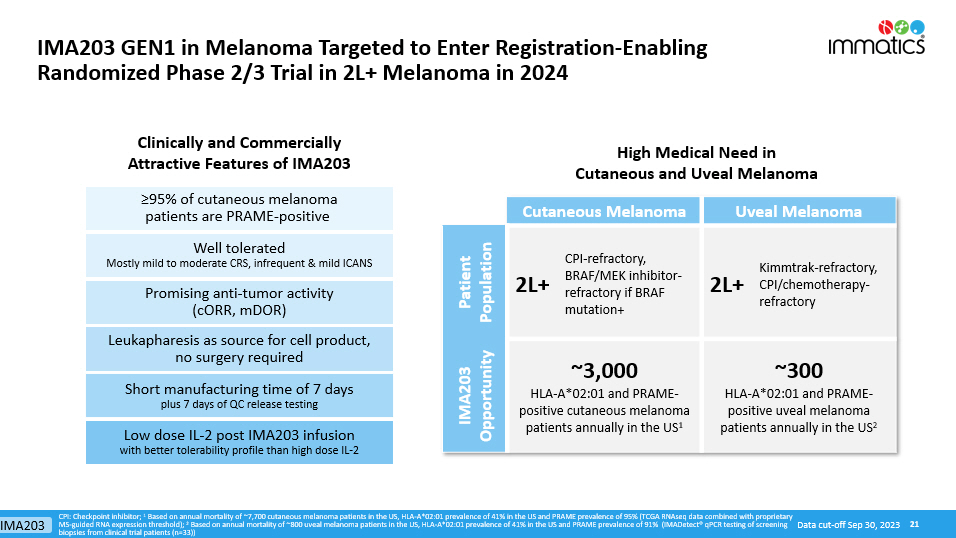
Median DOR is analyzed by using the Kaplan - Meier method; Median Follow - up is analyzed by using the reverse Kaplan - Meier method; PD: Progressive Disease; SD: Stable Disease; PR: Partial Response; cPR : Confirmed Partial Response; BL: Baseline; BOR: Best Overall Response; DOR: Duration of Response; Scans at approximately week 6, month 3 and then every 3 months # Patients in Phase 1a Median DOR, min, max DOR Not reached, 2.2+, 14.7+ months Median Follow - up 14.4 months IMA203 21 High Medical Need in Cutaneous and Uveal Melanoma Clinically and Commercially Attractive Features of IMA203 Cutaneous Melanoma Uveal Melanoma Patient Population 2L+ CPI - refractory, BRAF/MEK inhibitor - refractory if BRAF mutation+ 2L+ Kimmtrak - refractory, CPI/chemotherapy - refractory IMA203 Opportunity ~3,000 HLA - A*02:01 and PRAME - positive cutaneous melanoma patients annually in the US 1 ~300 HLA - A*02:01 and PRAME - positive uveal melanoma patients annually in the US 2 Well tolerated Mostly mild to moderate CRS, infrequent & mild ICANS Promising anti - tumor activity ( cORR , mDOR ) Leukapharesis as source for cell product, no surgery required Short manufacturing time of 7 days plus 7 days of QC release testing Low dose IL - 2 post IMA203 infusion with better tolerability profile than high dose IL - 2 CPI: Checkpoint inhibitor; 1 Based on annual mortality of ~7,700 cutaneous melanoma patients in the US, HLA - A*02:01 prevalence of 41% in the US and PRAME pr evalence of 95% (TCGA RNAseq data combined with proprietary MS - guided RNA expression threshold); 2 Based on annual mortality of ~800 uveal melanoma patients in the US, HLA - A*02:01 prevalence of 41% in the US and PRAME prevalen ce of 91% (IMADetect® qPCR testing of screening biopsies from clinical trial patients (n=33)) ≥95% of cutaneous melanoma patients are PRAME - positive Data cut - off Sep 30, 2023 IMA203 GEN1 in Melanoma Targeted to Enter Registration - Enabling Randomized Phase 2/3 Trial in 2L+ Melanoma in 2024 IMA203 ACTengine® IMA203 TCR - T Interim Update Delivering a Meaningful Benefit to Patients with an Unmet Medical Need 22 IMA203 GEN1 Monotherapy Phase 1a & Cohort A – Focus on Melanoma at RP2D IMA203CD8 GEN2 Monotherapy Cohort C – First Data Set on 2 nd Generation Summary & Next Development Steps IMA203
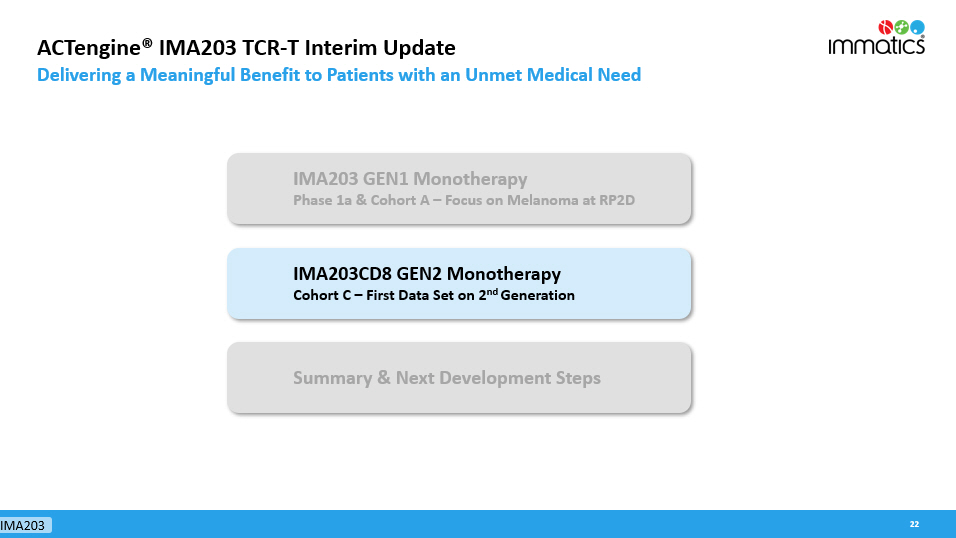
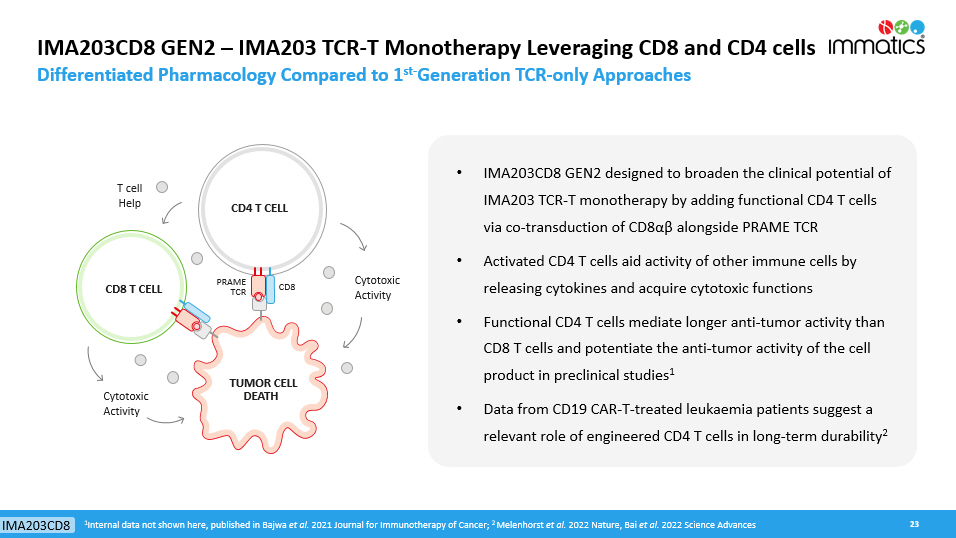
IMA203CD8 GEN2 – IMA203 TCR - T Monotherapy Leveraging CD8 and CD4 cells Differentiated Pharmacology Compared to 1 st - Generation TCR - only Approaches • IMA203CD8 GEN2 designed to broaden the clinical potential of IMA203 TCR - T monotherapy by adding functional CD4 T cells via co - transduction of CD8 αβ alongside PRAME TCR • Activated CD4 T cells aid activity of other immune cells by releasing cytokines and acquire cytotoxic functions • Functional CD4 T cells mediate longer anti - tumor activity than CD8 T cells and potentiate the anti - tumor activity of the cell product in preclinical studies 1 • Data from CD19 CAR - T - treated leukaemia patients suggest a relevant role of engineered CD4 T cells in long - term durability 2 TUMOR CELL DEATH CD4 T CELL Cytotoxic Activity CD8 T CELL T cell Help Cytotoxic Activity 23 1 Internal data not shown here, published in Bajwa et al. 2021 Journal for Immunotherapy of Cancer; 2 M elenhorst et al. 2022 Nature , Bai et al.
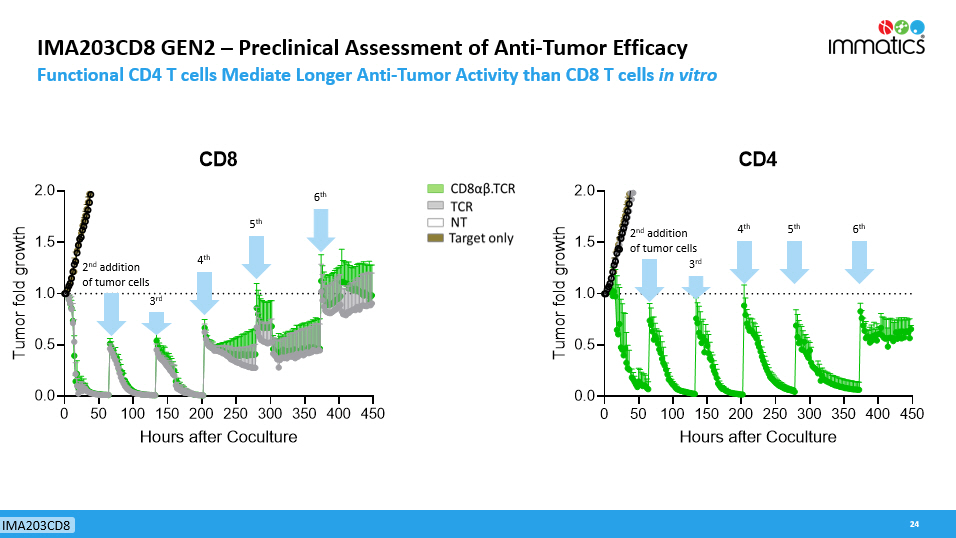
2022 Science Advances CD8 PRAME TCR IMA203CD8 IMA203CD8 GEN2 – Preclinical Assessment of Anti - Tumor Efficacy Functional CD4 T cells Mediate Longer Anti - Tumor Activity than CD8 T cells in vitro 24 0 50 100 150 200 250 300 350 400 450 0.0 0.5 1.0 1.5 2.0 CD8 Hours after Coculture T u m o r f o l d g r o w t h 0 50 100 150 200 250 300 350 400 450 0.0 0.5 1.0 1.5 2.0 CD4 Hours after Coculture T u m o r f o l d g r o w t h 2 nd addition of tumor cells 3 rd 4 th 5 th 6 th 2 nd addition of tumor cells 3 rd 4 th 5 th 6 th IMA203CD8 IMA203CD8 GEN2 in Cohort C (N=12) – Most Frequent Adverse Events Manageable Tolerability in 12 Patients Treated with IMA203CD8 at 3 Escalating Dose Levels 1 25 1 N=4 DL3, N=4 DL4a, N=4 DL4b, DL3: 0.2 - 0.48x10 9 TCR - T cells/m 2 BSA, DL4 is split into a DL4a (0.481 - 0.8x10 9 TCR - T cells/m 2 BSA) and DL4b (0.801 - 1.2x10 9 TCR - T cells/m 2 BSA); 2 I CANS: Immune Effector Cell - Associated N eurotoxicity S yndrome ; CRS and ICANS graded by CARTOX criteria ( Neelapu et al ., 2018); 3 Subsequent to data cut - off a Grade 5 event, possibly related to treatment, was observed.

The patient’s immediate cause of death was considered to be fatal sepsis, aggravated by the immunosuppression, a high - grade Immune Effector Cell - Associated Hemophagocytic Lymphohistiocytosis - Like Syndrome (IEC - HS), and the fast - progressing disease. IMA203CD8 GEN2 monotherapy shows a manageable tolerability profile Data cut - off Sep 30, 2023 IMA203CD8 • Expected cytopenia (Grade 1 - 4) associated with lymphodepletion in all patients • Cytokine release syndrome (CRS) in 92% (11/12) of patients: Trend towards more severe CRS at higher doses, in all cases well manageable • 67 % (8/12) with Grade 1 or 2 CRS (4 in DL3, 3 in DL4a, 1 in DL4b) • 17% (2/12) with Grade 3 CRS (2 in DL4b; patient C - DL4b - 04, see also description below) • 8% (1/12) with Grade 4 CRS (1 in DL4b, patient C - DL4b - 01, see also description below ) • One patient with neurotoxicity (see below), no ICANS 2 or neurotoxicity reported for the other patients • Dose - limiting toxicities (DLTs) at Dose Level 4b were observed in 2 of 4 patients 1) In patient C - DL4b - 01 treated with highest possible dose at DL4b, high biological activity ( in vivo T cell expansion) observed; patient developed Grade 4 neurotoxicity and Grade 4 CRS on day 6 after infusion, combined with Grade 3 Hemophagocytic Lymphohistiocytosis (HLH) 2) Patient C - DL4b - 04 treated at DL4b developed Grade 3 CRS with transient Grade 3 liver enzyme (ALT) increase that resolved to Grad e 2 within 10 days; no need for vasopressors or ventilation at any time • No high - grade CRS, no neurotoxicity and no DLTs were reported for 4 patients treated at DL3 and 4 patients treated at DL4a • No IMA203CD8 - related deaths 3 • Expanded DL4a dose cohort ongoing Tolerability Data – Cohort C IMA203CD8 GEN2 26 Adverse event ≥ Grade 3 ( System organ class , preferred term) No.

% Patients with any adverse event 12 100.0 Adverse events of special interest 3 25.0 Cytokine release syndrome 1 3 25.0 Immune effector cell - associated neurotoxicity syndrome 0 0.0 Blood and lymphatic system disorders 11 91.7 Neutropenia 9 75.0 Anaemia 8 66.7 Lymphopenia 8 66.7 Thrombocytopenia 4 33.3 Leukopenia 2 16.7 Investigations 4 33.3 Aspartate aminotransferase increased 2 16.7 Neutrophil count decreased 2 16.7 Alanine aminotransferase increased 1 8.3 Blood alkaline phosphatase increased 1 8.3 Blood bilirubin increased 1 8.3 Gamma - glutamyltransferase increased 1 8.3 Metabolism and nutrition disorders 2 16.7 Hypermagnesaemia 1 8.3 Hypoalbuminaemia 1 8.3 Hypophosphataemia 1 8.3 Nervous system disorders 2 16.7 Neurotoxicity 2 1 8.3 Syncope 1 8.3 Immune system disorders 1 8.3 Haemophagocytic lymphohistiocytosis 2 1 8.3 Infections and infestations 1 8.3 Infection 1 8.3 All treatment - emergent adverse events (TEAEs) with ≥ Grade 3 regardless of relatedness to study treatment that occurred in at least 1 patient ( except for ICANS, where no event was documented; listed for completeness due to being an adverse event of special interest) are presented. Adverse events were coded using the Medical Dictionary for Regulatory Activities. Grades were determined according to National Cancer Institute Common Terminology Criteria of Adverse Events, version 5.0. Grades for CRS and ICANS were determined according to CARTOX criteria ( Neelapu et al., 2018). Patients are counted only once per adverse event and severity classification. Based on interim data extracted from open clinical database (30 - Sep - 2023) ; 1 DLT: Dose limiting toxicity in patient DL4b - 04. 2 DLTs in patient DL4b - 01; All ≥Grade 3 Adverse Events (N=12) TEAEs by maximum severity for all patients in Cohort C (N= 12 ) • Manageable tolerability • Most frequent ≥Grade 3 AEs were expected cytopenia associated with lymphodepletion • No IMA203CD8 - related Grade 5 Adverse Events 1 • Dose escalation ongoing Data cut - off Sep 30, 2023 1 Subsequent to data cut - off a Grade 5 event, possibly related to treatment, was observed. The patient’s immediate cause of death was considered to be fatal sepsis, aggravated by the immunosuppression, a high - grade Immune Effector Cell - Associated Hemophagocytic Lymphohistiocytosis - Like Syndrome (IEC - HS), and the fast - progressing disease.

IMA203CD8 IMA203CD8 GEN2 in Cohort C (N=12 # ) – BOR and Response over Time Deepening of Response from SD to PR in 2 Patients, 6 Responses Ongoing 27 • 6 out of 7 responses ongoing • 11/12 patients show tumor shrinkage • Deepening of response from SD to PR in two patients (C - DL4a - 01, C - DL4a - 03) • Ongoing durable response 12+ months after infusion Median DOR, min, max DOR Not reached, 2.0+, 11.5+ months Median Follow - up 4.8 months ORR 58% (7/12) cORR 56% (5/9) Initial ORR: Objective response rate according to RECIST 1.1 at any post infusion scan; Confirmed ORR ( cORR ): Confirmed objective response rate according to RECIST 1.1 for patients with at least two available post infusion scans or pat ients with progressive disease (PD) at any prior timepoint, patients with ongoing unconfirmed PR not included in cORR calculation; Duration of response (DOR) in confirmed responders is defined as time from first documented response until disease progression/death. Patients with ongoing response will be censored at date of data cut - off. Median DOR is analyzed by using the Kaplan - Meier method; Median Follow - up is analyzed by using the reverse Kaplan - Meier method; PD: Progressive Disease; SD: Stable Disease; PR: Partial Response; cPR : Confirmed Partial Response; BL: Baseline; BOR: Best Overall Response; DOR: Duration of Response # Patient C - DL4a - 04 was PD ~6 weeks after infusion, not shown due to non - evaluable target lesions at tumor assessment Scans at approximately week 6, month 3 and then every 3 months Ongoing Data cut - off Sep 30, 2023 * Clinical tumor progress after 4.9 months post infusion, investigator information * IMA203CD8 IMA203CD8 GEN2: Translational Data Shows Enhanced Pharmacology Cohort A IMA203 GEN1 (All Patients at RP2D) vs Cohort C IMA203CD8 GEN2 28 Trend towards responses at lower cell dose and higher tumor burden with IMA203CD8 Higher peak expansion ( C max ) of IMA203CD8 T cells when normalized to infused dose Higher activation levels in IMA203CD8 T cells at week 1… …without exhaustion over time Initial translational data indicates higher biological and clinical activity of IMA203CD8 GEN2 % PD - 1 of specific T cells at week1: for patient A - DL5 - 05 data not available for week 1 0 5×10 5 1×10 6 1.5×10 6 2×10 6 2.5×10 6 V e c t o r c o p i e s / μ g g D N A p=0.0010 PR cPR PD/SD Cohort A IMA203 GEN1 Cohort C IMA203CD8 GEN2 Data cut - off Sep 30, 2023 IMA203CD8
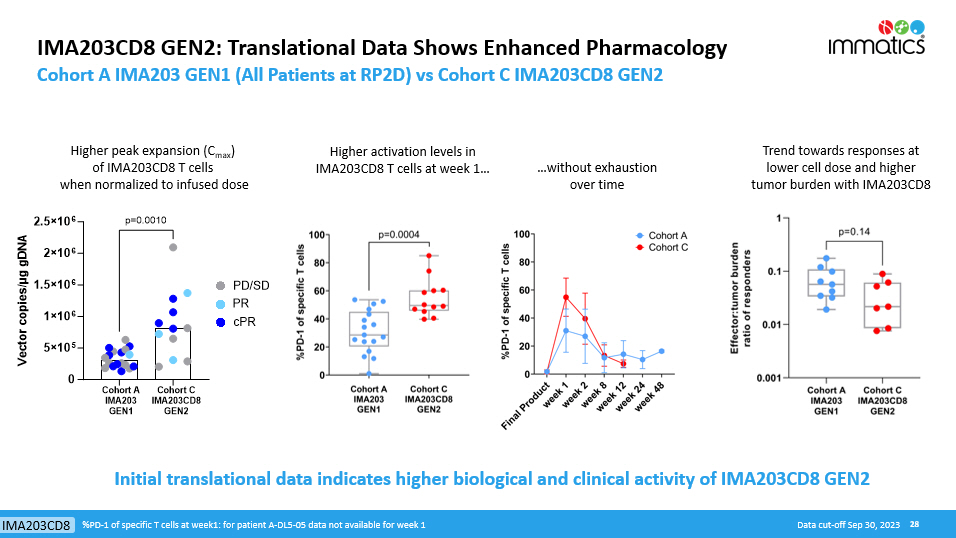


ACTengine® IMA203 TCR - T Interim Update Delivering a Meaningful Benefit to Patients with an Unmet Medical Need 29 IMA203 GEN1 Monotherapy Phase 1a & Cohort A – Focus on Melanoma at RP2D IMA203CD8 GEN2 Monotherapy Cohort C – First Data Set on 2 nd Generation Summary & Next Development Steps IMA203 ACTengine® IMA203 / IMA203CD8 TCR - T Monotherapy Targeting PRAME Summary of GEN1 and GEN2 Clinical Data and Planned Next Steps 30 Next Step Ongoing alignment with FDA on patient population, trial design, CMC targeting registration - enabling randomized Phase 2/3 trial in 2L+ melanoma • Well tolerated, mostly mild to moderate CRS, infrequent & mild ICANS • 50% (6/12) cORR , mDOR not reached at mFU of 14.4 months • Durability with ongoing responses at 15+ months in some patients • RP2D defined at 1 - 10x10 9 total TCR - T cells • FDA RMAT designation received in multiple PRAME expressing cancers including cutaneous and uveal melanoma • Enhanced primary and secondary pharmacology when compared to GEN1 • Manageable tolerability (2 DLTs at DL4b, dose escalation ongoing) • Initial clinical activity observed with differentiated response pattern • 56% (5/9) cORR • 6 out of 7 responses ongoing at data cut - off, durable response at 12+ months • SD converting to PR over time (N=2) • Enhanced biological efficacy with PRs at lower T cell:tumor cell ratio compared to IMA203 GEN1 IMA203 GEN1 Monotherapy in Melanoma at RP2D IMA203CD8 GEN2 Monotherapy IMA203 GEN1 Monotherapy in Melanoma at RP2D Next Step Clinical footprint expansion outside of melanoma in addition to treating melanoma patients Data cut - off Sep 30, 2023 IMA203 PRAME mRNA expression in IMA203 GEN1 Phase 1a and Cohort A responders at RP2D (n=13) PRAME mRNA expression in IMA203CD8 GEN2 Cohort C responders (n=7) Potential of IMA203 in Additional Solid Cancer Indications Based on PRAME Expression in IMA203 GEN1 and IMA203CD8 GEN2 Responders 31 % PRAME - positive patients 1 PRAME target expression distribution (blue histogram) based on TCGA RNAseq data, patient data (black dots) based on IMADetect ® q PCR testing of screening biopsies; 1 PRAME target prevalence is based on TCGA RNAseq data combined with a proprietary MS - guided RNA expression threshold; 2 PRAME target prevalence in uveal melanoma based on IMADetect® qPCR testing of screening biopsies from clinical trial patients ( n=33) demonstrates substantial higher prevalence of 91% compared to prevalence based on TCGA data of 50%, TCGA: early & late - stage primary tumor samples, Immatics clinical trials: late - stage/metastatic tumor samples, Role of PRAME in metastasis of uveal melanoma: Field et al.
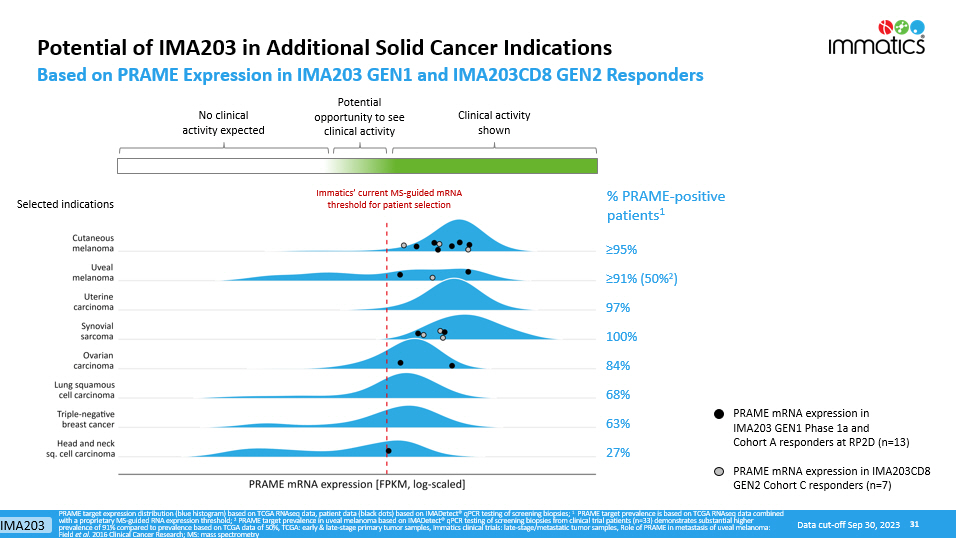
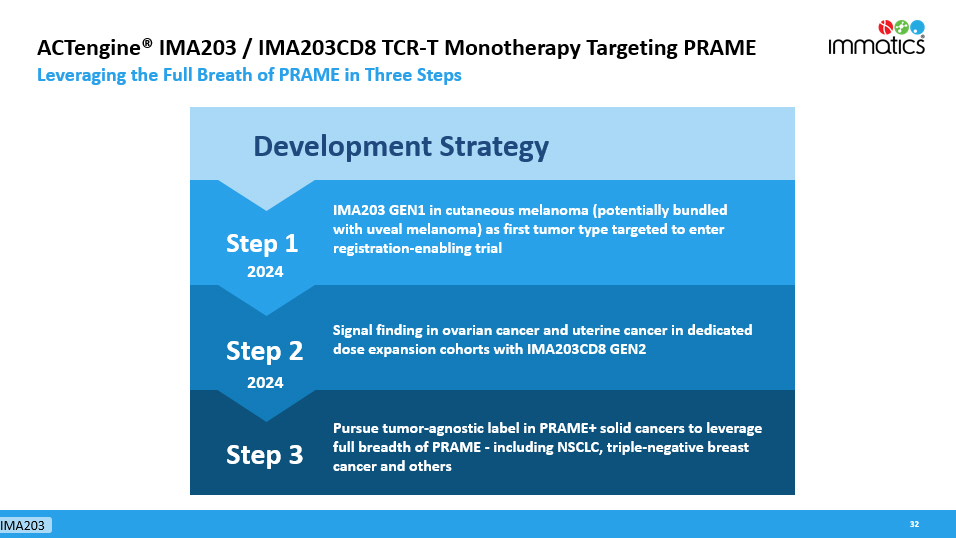
2016 Clinical Cancer Research; MS: mass spectrometry Data cut - off Sep 30, 2023 ≥ 95% ≥ 91% (50% 2 ) 97% 100% 84% 68% 63% 27% Immatics’ current MS - guided mRNA threshold for patient selection Selected indications Clinical activity shown No clinical activity expected Potential opportunity to see clinical activity IMA203 ACTengine® IMA203 / IMA203CD8 TCR - T Monotherapy Targeting PRAME Leveraging the Full Breath of PRAME in Three Steps 32 Development Strategy Step 1 IMA203 GEN1 in cutaneous melanoma (potentially bundled with uveal melanoma) as first tumor type targeted to enter registration - enabling trial Signal finding in ovarian cancer and uterine cancer in dedicated dose expansion cohorts with IMA203CD8 GEN2 Pursue tumor - agnostic label in PRAME+ solid cancers to leverage full breadth of PRAME - including NSCLC, triple - negative breast cancer and others Step 2 Step 3 2024 2024 IMA203 ACTengine® IMA203 TCR - T Product Manufacturing Enhancing Manufacturing Process and Capabilities 1 - week manufacturing process followed by 1 - week QC release testing High manufacturing success rate of >95% to reach IMA203 / IMA203CD8 target dose* Lean and cost - efficient process Proprietary Manufacturing Process 33 IMA203 SHORT SIMPLE ROBUST *IMA203 GEN1: RP2D 1 - 10x10 9 total TCR - T cells, IMA203CD8 GEN2: DL4a 0.481 - 0.8x10 9 TCR - T cells/m 2 BSA Manufacturing of ACTengine ® candidates & other future autologous /allogeneic candidates Construction completed in 2024 ~100,000 sq ft in Houston area, TX – m odular design for efficient and cost - effective scalability Early - stage and registration - directed clinical trials as well as initial commercial supply State - of - the - art Research & GMP Manufacturing Facility
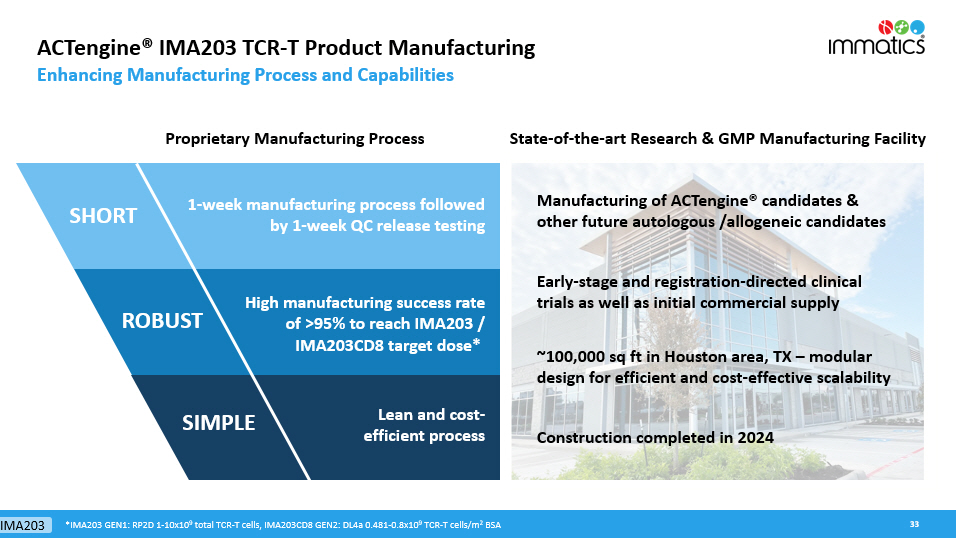
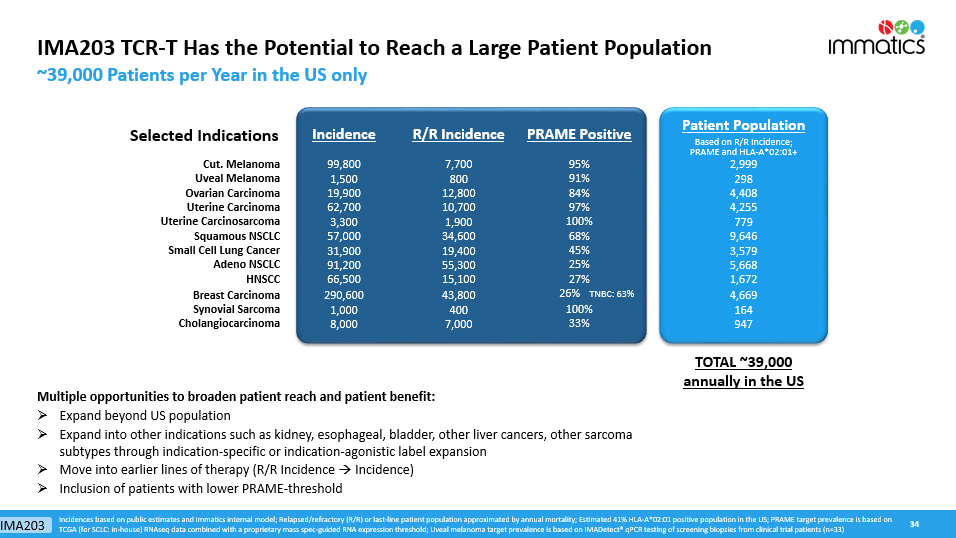
Selected Indications Incidence R/R Incidence PRAME Positive Patient Population Based on R/R Incidence; PRAME and HLA - A*02:01+ Cut. Melanoma 99,800 7,700 95% 2,999 Uveal Melanoma 1,500 800 91% 298 Ovarian Carcinoma 19,900 12,800 84% 4,408 Uterine Carcinoma 62,700 10,700 97% 4,255 Uterine Carcinosarcoma 3,300 1,900 100% 779 Squamous NSCLC 57,000 34,600 68% 9,646 Small Cell Lung Cancer 31,900 19,400 45% 3 ,579 Adeno NSCLC 91,200 55,300 25% 5,668 HNSCC 66,500 15,100 27% 1,672 Breast Carcinoma 290,600 43,800 26% TNBC: 63% 4,669 Synovial Sarcoma 1,000 400 100% 164 Cholangiocarcinoma 8,000 7,000 33% 9 47 IMA203 TCR - T Has the Potential to Reach a Large Patient Population ~39,000 Patients per Year in the US only 34 Incidences based on public estimates and Immatics internal model; Relapsed/refractory (R/R) or last - line patient population approximated by annual mortality; Estimated 41% HLA - A*02:01 positive population in the US; PRAME target prevalence is based on TCGA (for SCLC: in - house) RNAseq data combined with a proprietary mass spec - guided RNA expression threshold ; Uveal melanoma target prevalence is based on IMADetect® qPCR testing of screening biopsies from clinical trial patients (n= 33) Multiple opportunities to broaden patient reach and patient benefit: » Expand beyond US population » Expand into other indications such as kidney, esophageal, bladder, other liver cancers, other sarcoma subtypes through indication - specific or indication - agonistic label expansion » Move into earlier lines of therapy (R/R Incidence Incidence ) » Inclusion of patients with lower PRAME - threshold TOTAL ~ 39 ,000 annually in the US IMA203 ACTengine® IMA204 – TCR - T Targeting COL6A3 Exon 6 35

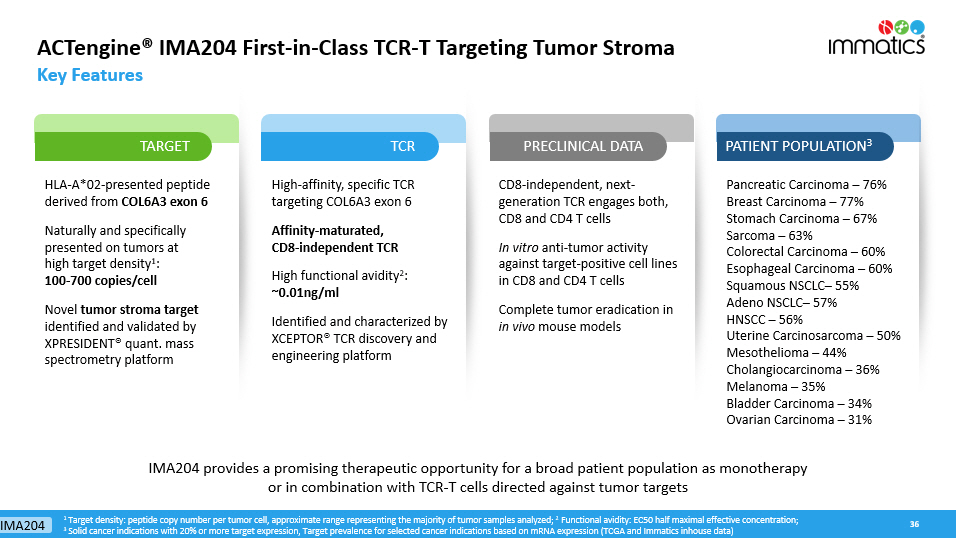
ACTengine® IMA204 First - in - Class TCR - T Targeting Tumor Stroma Key Features 36 HLA - A*02 - presented peptide derived from COL6A3 exon 6 Naturally and specifically presented on tumors at high target density 1 : 100 - 700 copies/cell Novel tumor stroma target identified and validated by XPRESIDENT® quant. mass spectrometry platform High - affinity, specific TCR targeting COL6A3 exon 6 Affinity - maturated, CD8 - independent TCR High functional avidity 2 : ~0.01ng/ml Identified and characterized by XCEPTOR® TCR discovery and engineering platform CD8 - independent, next - generation TCR engages both, CD8 and CD4 T cells In vitro anti - tumor activity against target - positive cell lines in CD8 and CD4 T cells Complete tumor eradication in in vivo mouse models Pancreatic Carcinoma – 76% Breast Carcinoma – 77% Stomach Carcinoma – 67% Sarcoma – 63% Colorectal Carcinoma – 60% Esophageal Carcinoma – 60% Squamous NSCLC – 55% Adeno NSCLC – 57% HNSCC – 56% Uterine Carcinosarcoma – 50% Mesothelioma – 44% Cholangiocarcinoma – 36% Melanoma – 35% Bladder Carcinoma – 34% Ovarian Carcinoma – 31% 1 Target density: peptide copy number per tumor cell, approximate range representing the majority of tumor samples analyzed; 2 Functional avidity: EC50 half maximal effective concentration; 3 Solid cancer indications with 20% or more target expression, Target prevalence for selected cancer indications based on mRNA expression (TCGA and Immatics inhouse data) TARGET TCR PREC LINICAL DATA PATIENT POPULATION 3 IMA204 provides a promising therapeutic opportunity for a broad patient population as monotherapy or in combination with TCR - T cells directed against tumor targets IMA204 ACTengine® IMA204 – High Affinity, CD8 - independent TCR Complete Tumor Eradication in vitro & in vivo 1 by Affinity - enhanced IMA204 TCR CD8 - independent TCR leads to tumor eradication in all mice treated 37 Control IMA204 TCR D7 D16 D22 D29 Affinity maturated CD8 - independent, next - generation TCR engages both CD4 and CD8 T cells without the need of CD8 co - transduction Stroma cells Tumor cells Stroma Target (COL6A3 exon 6) in Ovarian Cancer sample Example of a Tumor Target in same Ovarian Cancer sample 1 In vivo data in collaboration with Jim Riley, University of Pennsylvania, control: non - transduced T cells.
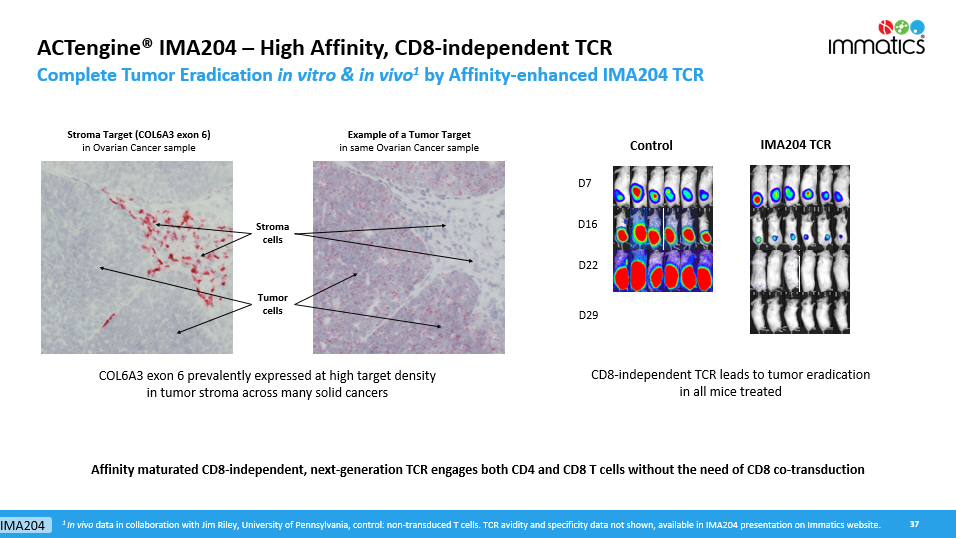
TCR avidity and specificity d ata not shown, available in IMA204 presentation on Immatics website. COL6A3 exon 6 prevalently expressed at high target density in tumor stroma across many solid cancers IMA204 ACTallo® – Our Next - generation Off - the - shelf TCR - T 38
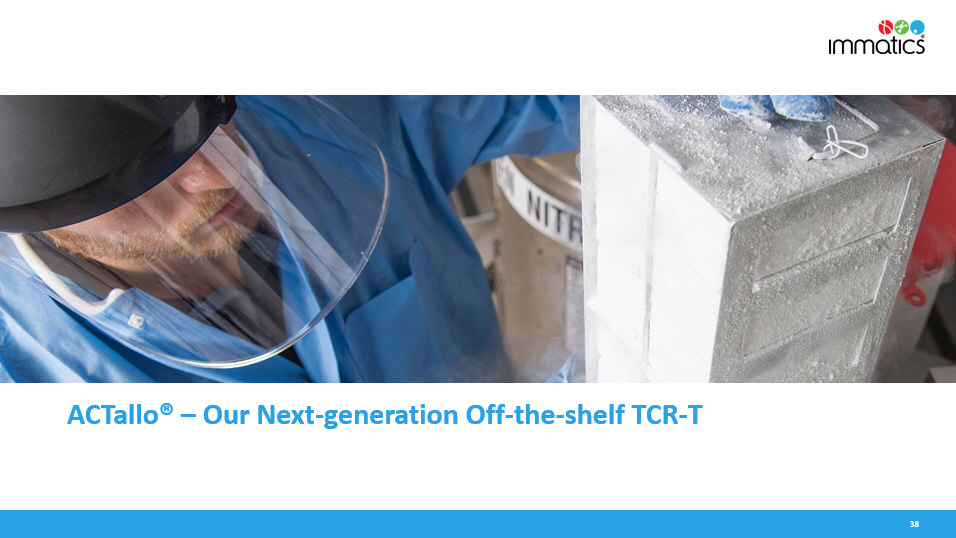
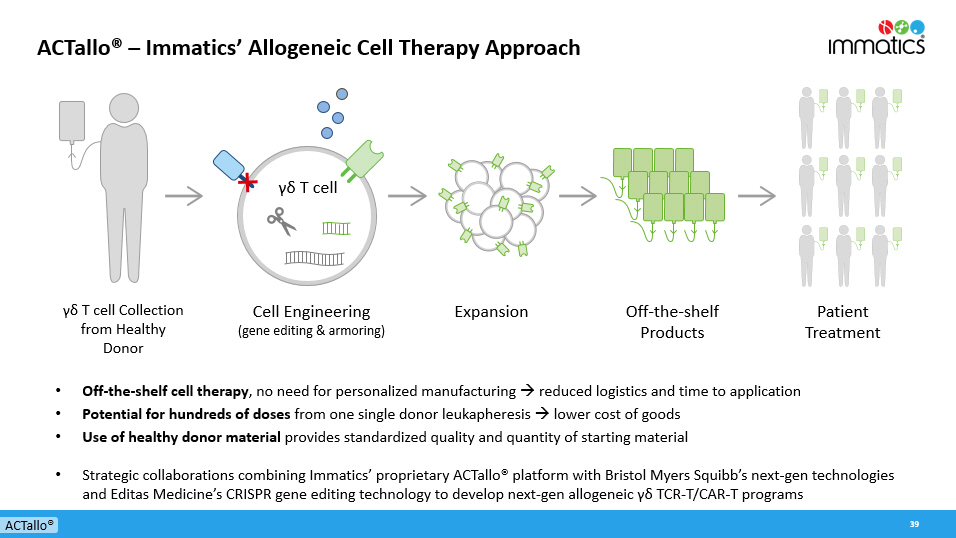
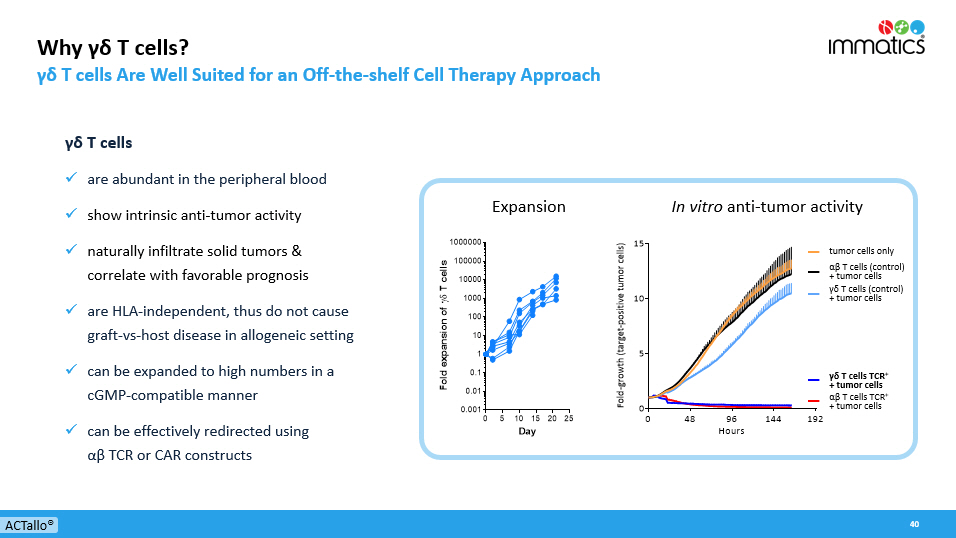
ACTallo® – Immatics’ Allogeneic Cell Therapy Approach • Off - the - shelf cell therapy , no need for personalized manufacturing reduced logistics and time to application • Potential for hundreds of doses from one single donor leukapheresis lower cost of goods • Use of healthy donor material provides standardized quality and quantity of starting material • Strategic collaborations combining Immatics’ proprietary ACTallo ® platform with Bristol Myers Squibb’s next - gen technologies and Editas Medicine’s CRISPR gene editing technology to develop next - gen allogeneic γδ TCR - T/CAR - T programs 39 ACTallo® γδ T cell Cell Engineering (gene editing & armoring ) γδ T cell Collection from Healthy Donor Expansion Off - the - shelf Products Patient Treatment Why γδ T cells? γδ T cells Are Well Suited for an Off - the - shelf Cell Therapy Approach 40 γδ T cells x are abundant in the peripheral blood x show intrinsic anti - tumor activity x naturally infiltrate solid tumors & correlate with favorable prognosis x are HLA - independent, thus do not cause graft - vs - host disease in allogeneic setting x can be expanded to high numbers in a cGMP - compatible manner x can be effectively redirected using αβ TCR or CAR constructs In vitro a nti - tumor activity 0 48 96 144 192 0 5 10 15 Hours F o l d G r o w t h ( U 2 0 S - R F P + ) Tumor cells only T cells (NT) T cells IMA203 TCR + T cells (NT) T cells IMA203 TCR + γδ T cells (control) + tumor cells tumor cells only αβ T cells (control) + tumor cells γδ T cells TCR + + tumor cells αβ T cells TCR + + tumor cells ACTallo® 0 5 10 15 20 25 0.001 0.01 0.1 1 10 100 1000 10000 100000 1000000 Day F o l d e x p a n s i o n o f T c e l l s Expansion Fold - growth (target - positive tumor cells)
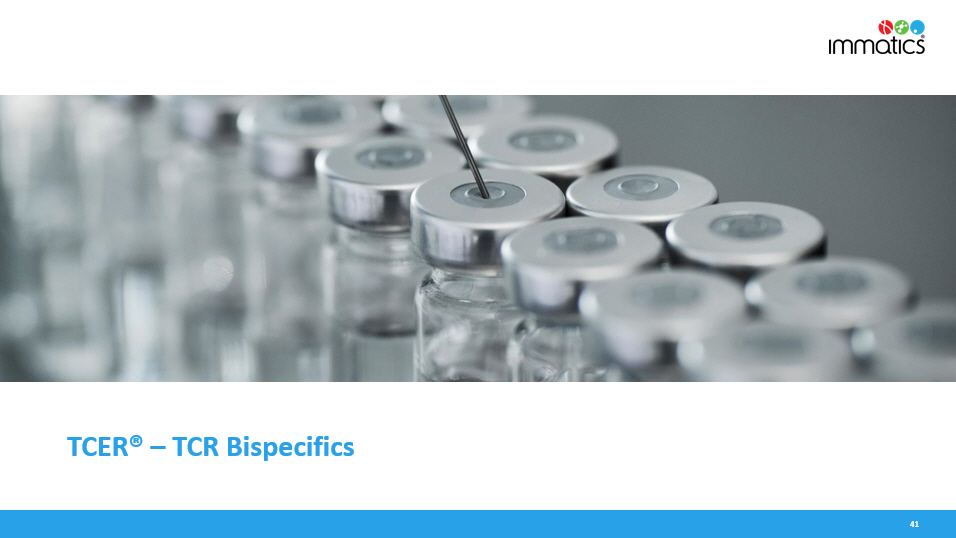
TCER® – TCR Bispecifics 41
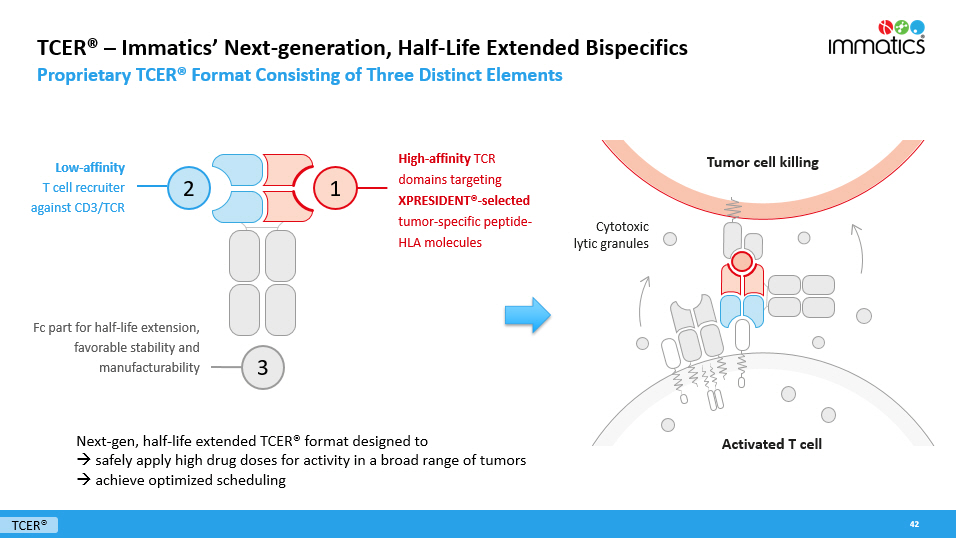
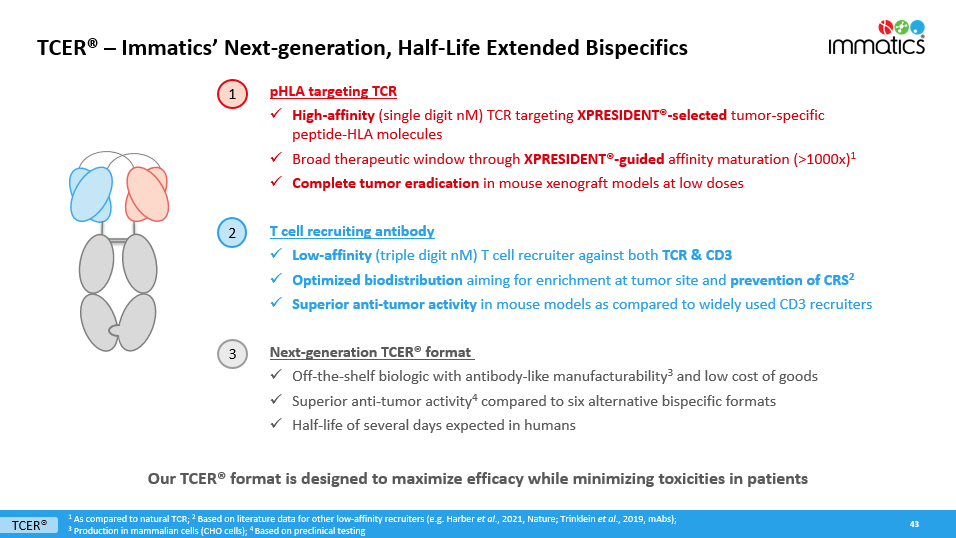
TCER® – Immatics ’ Next - generation, Half - Life Extended Bispecifics Proprietary TCER® Format Consisting of Three Distinct Elements 42 High - affinity TCR domains targeting XPRESIDENT® - selected tumor - specific peptide - HLA molecules Low - affinity T cell recruiter against CD3/TCR Fc part for half - life extension, favorable stability and manufacturability Next - gen, half - life extended TCER® format designed to safely apply high drug doses for activity in a broad range of tumors achieve optimized scheduling 2 1 3 Cytotoxic lytic granules T umor cell killing A ctivated T cell TCER® TCER® – Immatics’ Next - generation, Half - Life Extended Bispecifics 43 pHLA targeting TCR x High - affinity (single digit nM ) TCR targeting XPRESIDENT® - selected tumor - specific peptide - HLA molecules x Broad therapeutic window through XPRESIDENT® - guided affinity maturation (>1000x) 1 x Complete tumor eradication in mouse xenograft models at low doses T cell recruiting antibody x Low - affinity (triple digit nM ) T cell recruiter against both TCR & CD3 x Optimized biodistribution aiming for enrichment at tumor site and prevention of CRS 2 x Superior anti - tumor activity in mouse models as compared to widely used CD3 recruiters Next - generation TCER® format x Off - the - shelf b iologic with antibody - like manufacturability 3 and low cost of goods x Superior anti - tumor activity 4 compared to six alternative bispecific formats x Half - life of several days expected in humans Our TCER® format is designed to maximize efficacy while minimizing toxicities in patients 1 As compared to natural TCR; 2 Based on literature data for other low - affinity recruiters (e.g.
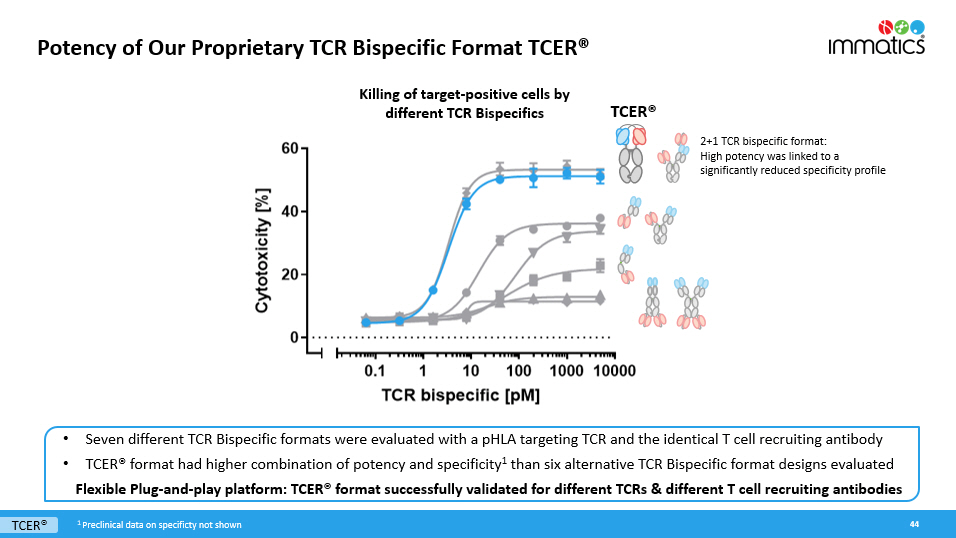
Harber et al ., 2021, Nature; Trinklein et al ., 2019, mAbs ) ; 3 Production in mammalian cells (CHO cells); 4 Based on preclinical testing TCER® 1 2 3 Potency of Our Proprietary TCR Bispecific Format TCER® 44 • Seven different TCR Bispecific formats were evaluated with a pHLA targeting TCR and the identical T cell recruiting antibody • TCER® format had higher combination of potency and specificity 1 than six alternative TCR Bispecific format designs evaluated Flexible Plug - and - play platform: TCER® format successfully validated for different TCRs & different T cell recruiting antibodies TCER® TCER® 2+1 TCR bispecific format: High potency was linked to a significantly reduced specificity profile Killing of target - positive cells by different TCR Bispecifics 1 Preclinical data on specificty not shown TCER® Format Is Designed for Optimized Efficacy and Safety Superior Tumor Control Using a Novel, Low - Affinity Recruiter 45 Widely used T cell recruiting Ab (3 variants) medium to high affinity (single to double digit nM ) n = 6 mice/treatment group, n = 10 mice in vehicle group, 2 donors/group Dose: 0.025 mg/kg Proprietary, low - affinity T cell recruiting region demonstrates superior tumor control compared to analogous TCER® molecules designed with higher - affinity variants of a widely used recruiter Immatics’ T cell recruiting Ab low affinity (triple digit nM ) TCER® Tumor Model in Mice 1 1 Hs695T xenograft model in NOG m ice , tumor volume of group means shown
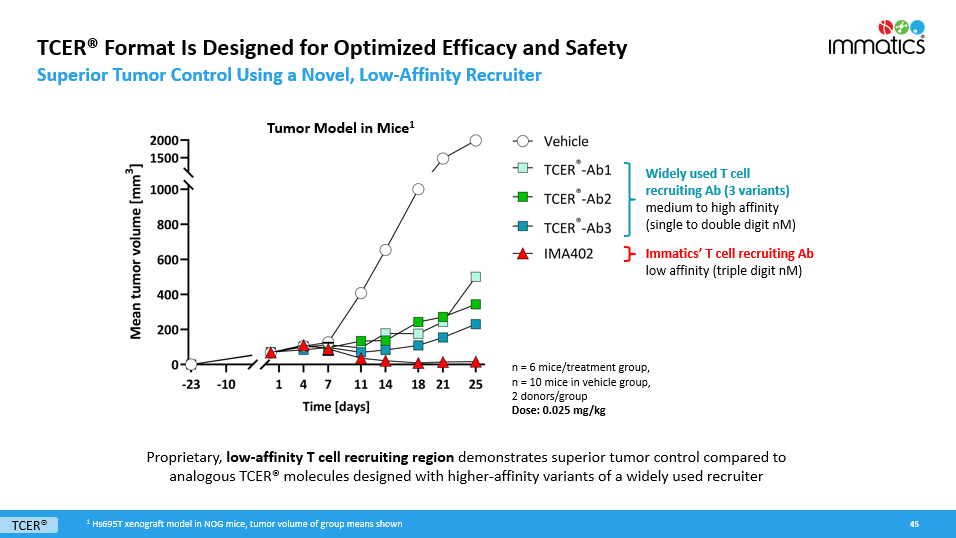
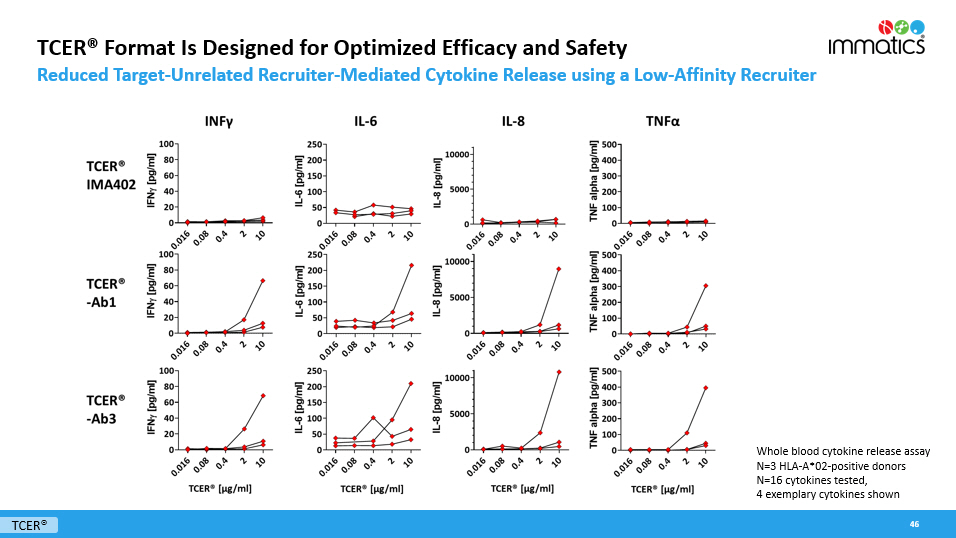

TCER® Format Is Designed for Optimized Efficacy and Safety Reduced Target - Unrelated Recruiter - Mediated Cytokine Release using a Low - Affinity Recruiter 46 TCER® Whole blood cytokine release assay N= 3 HLA - A*02 - positive donors N=16 cytokines tested, 4 exemplary cytokines shown Our TCER® Portfolio Broad Pipeline of Next - Gen Half - Life Extended TCR Bispecifics 47 TCER® • PRAME peptide presented by HLA - A*02:01 • Start of clinical trial in Aug 2023, first clinical data expected 2H 2024 IMA402 Potential for addressing different indications and large patient populations with novel, off - the - shelf TCR Bispecifics • MAGEA4/8 peptide presented by HLA - A*02:01 • Dose escalation ongoing, first clinical data expected 2H 2024 IMA401 • Undisclosed peptides presented by HLA - A*02:01 and other HLA - types • TCER® engineering and preclinical testing ongoing IMA40x Several innovative programs CLINICAL PRECLINICAL The current collaboration with Moderna includes the development of mRNA - enabled in vivo expressed TCER® molecules TCER® IMA401 Targeting MAGEA4/8 Homogeneous Expression, Broad Prevalence and High Copy Number Target 48 MAGEA4 RNA detection in tumor samples (ISH) Indications Target p revalence [%] Squamous non - small cell lung carcinoma 52% Head and neck squamous cell carcinoma 36% Bladder carcinoma 29% Uterine carcinosarcoma 29% Esophageal carcinoma 23% Ovarian carcincoma 23% Melanoma 18% plus several further indications MAGEA4/8 target prevalence in selected cancer indications MAGEA4/8 target prevalences are based on TCGA data combined with a XPRESIDENT® - determined target individual MS - based mRNA expression threshold; 1 Copy number per tumor cell (CpC) measured on a paired - sample basis by AbsQuant®, i.e. comparing MAGEA4 vs. MAGEA4/A8 peptide presentation on same sample, 2 Students paired T test IMA401 p<0.001 2 MAGEA4/8 target is presented at >5 - fold higher target density 1 than a commonly used MAGEA4 target peptide
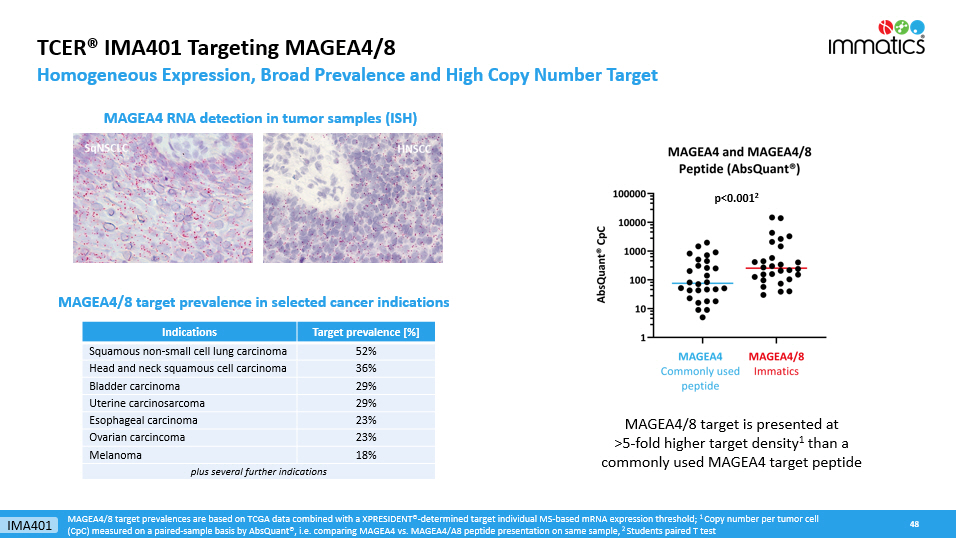
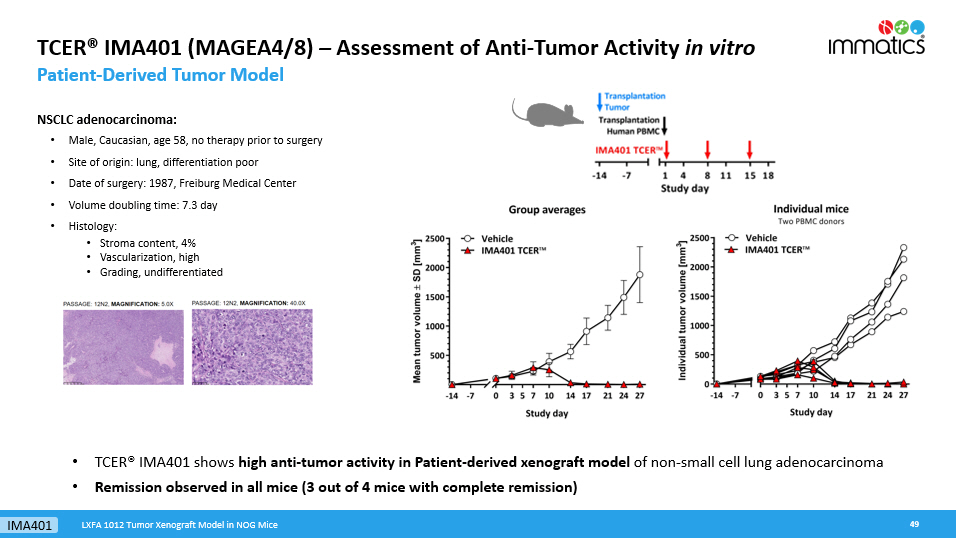
TCER® IMA401 (MAGEA4/8) – Assessment of Anti - Tumor Activity in vitro Patient - Derived Tumor Model 49 NSCLC adenocarcinoma : • M ale, Caucasian, age 58, no therapy prior to surgery • Site of origin: lung, differentiation poor • Date of surgery: 1987, Freiburg Medical Center • Volume doubling time: 7.3 day • Histology: • Stroma content, 4% • Vascularization, high • Grading, undifferentiated • TCER® IMA401 shows high anti - tumor activity in Patient - derived xenograft model of non - small cell lung adenocarcinoma • Remission observed in all mice (3 out of 4 mice with complete remission) LXFA 1012 Tumor Xenograft Model in NOG Mice IMA401 50 TCER® IMA401 (MAGEA4/8) – Pharmacokinetics PK Analysis in NOG Mice • Two different PK assays established to ensure functional integrity of protein domains • Terminal half - life in mice: 10 - 11 days pHLA – V L Assay Fc – V L Assay IMA401
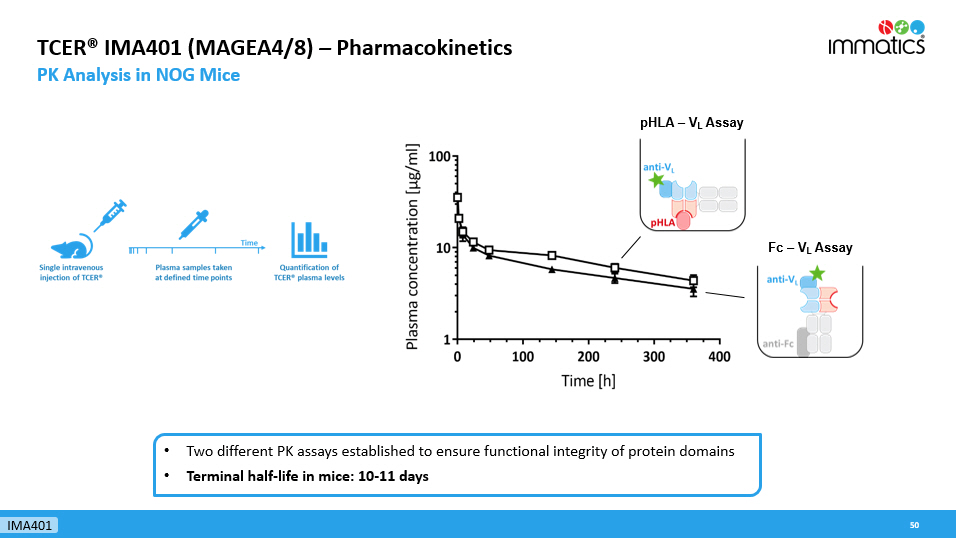

Phase 1 Clinical Trial to Evaluate TCER® IMA401 Targeting MAGEA4/8 51 MTD: maximum tolerated dose, RP2D: recommended phase 2 dose; BLRM: Bayesian logistic regression model; 1 P harmacokinetics data assessed throughout the trial might provide an opportunity to optimize scheduling to a less frequent regimen. 2 Conducted in collaboration with BMS Phase 1a: Dose Escalation Phase 1b: Dose Expansion • Weekly i.v.

infusions 1 • Dose escalation decisions based on cohorts of 1 - 6 patients in adaptive design (BLRM model) MTD/ RP2D Adaptive design aimed at accelerating dose escalation • Focus on specific indications planned Potential development option for checkpoint inhibitor combination or other combination therapies 2 Monotherapy expansion cohort Primary Objective • Determine MTD and/or RP2D Secondary Objectives • Safety and tolerability • Initial anti - tumor activity • Pharmacokinetics IMA401 TCER® IMA402 Targeting PRAME – Efficacy Assessment in vitro Tumor Cell Killing at Low Physiological PRAME Peptide Levels 52 0 20 40 60 80 100 120 140 10 -1 10 0 10 1 10 2 10 3 10 4 10 5 IMA402 [pM] Cytotoxicity [%] ~50 PRAME CpCs 0 0 20 40 60 80 100 120 140 10 -1 10 0 10 1 10 2 10 3 10 4 10 5 IMA402 [pM] Cytotoxicity [%] Target-negative 0 0 20 40 60 80 100 120 140 10 -1 10 0 10 1 10 2 10 3 10 4 10 5 IMA402 [pM] Cytotoxicity [%] ~110 PRAME CpCs 0 0 20 40 60 80 100 120 140 10 -1 10 0 10 1 10 2 10 3 10 4 10 5 IMA402 [pM] Cytotoxicity [%] ~250 PRAME CpCs 0 • TCER® IMA402 induces killing of tumor cells with PRAME target copies as low as 50 CpCs • Physiological PRAME levels detected in majority of cancer tissues from patients are 100 – 1000 CpCs • Preclinical activity profile enables targeting of a broad variety of tumor indications, such as lung cancer, breast cancer, ovarian cancer, uterine cancer, melanoma and others IMA402 CpC: Target peptide copy numbers per tumor cell TCER® IMA402 Achieves Durable Tumor Control of Large Tumors in vivo 53 -29 0 500 1000 1500 2000 2500 0 10 20 30 40 50 60 70 Study day M e d i a n t u m o r v o l u m e [ m m 3 ] Vehicle IMA402 [0.01 mg/kg] IMA402 [0.05 mg/kg] IMA402 [0.25 mg/kg] • Dose - dependent efficacy of IMA402 in cell line - derived in vivo mouse model • Durable shrinkage of large tumors including complete responses over prolonged period • Sufficiently high drug doses are key to achieving desired anti - tumor effect IMA402
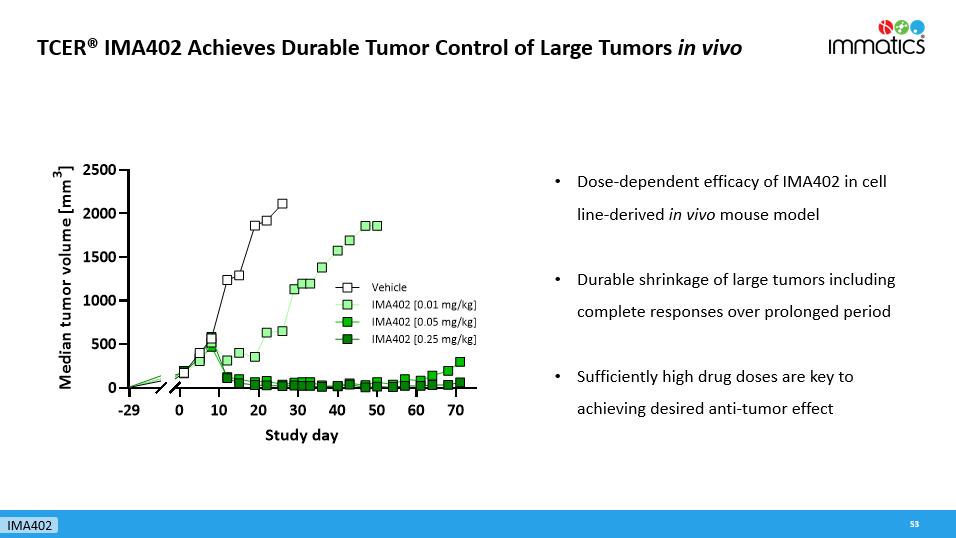
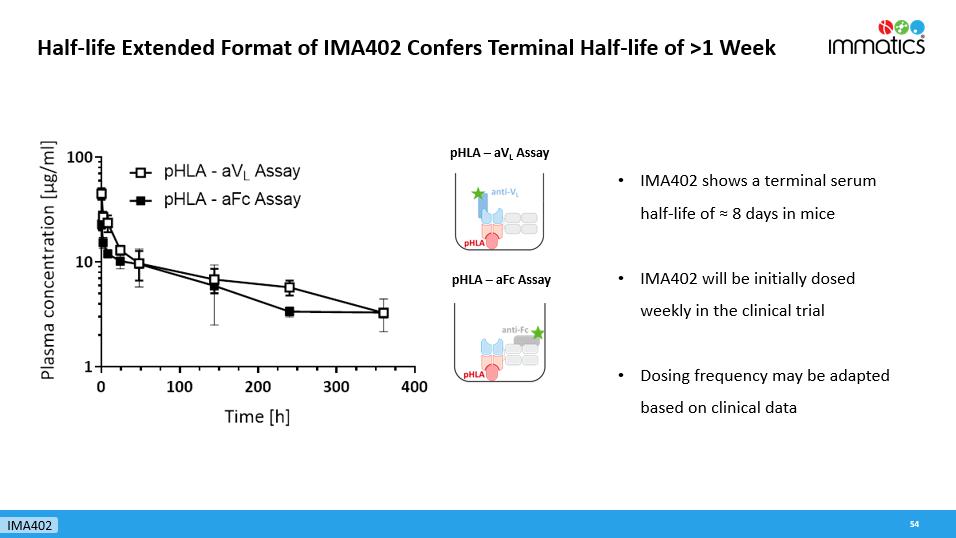
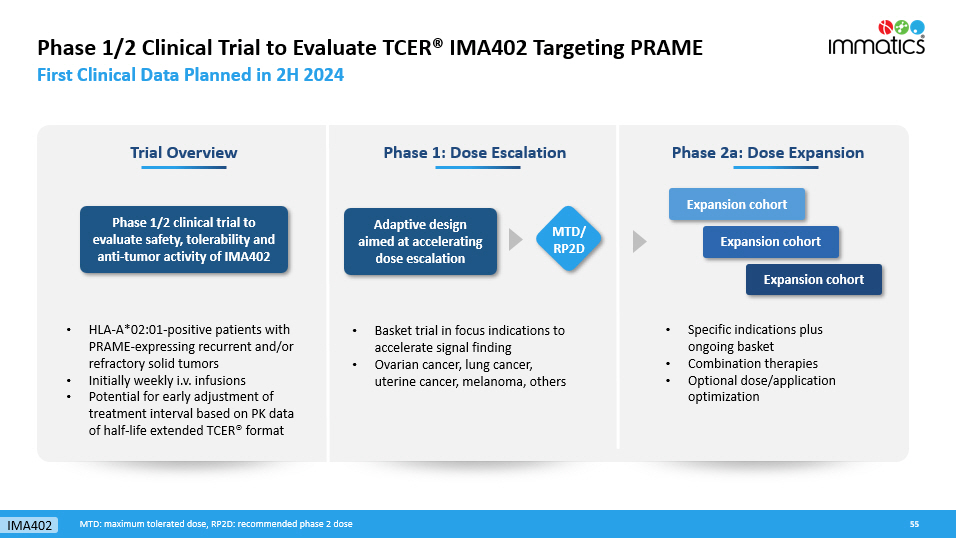
Half - life Extended Format of IMA402 Confers Terminal Half - life of >1 Week 54 pHLA – aV L Assay pHLA – aFc Assay • IMA402 shows a terminal serum half - life of ≈ 8 days in mice • IMA402 will be initially dosed weekly in the clinical trial • Dosing frequency may be adapted based on clinical data IMA402 Phase 1/2 Clinical Trial to Evaluate TCER® IMA402 Targeting PRAME First Clinical Data Planned in 2H 2024 55 Phase 1: Dose Escalation Phase 2a: Dose Expansion Adaptive design aimed at accelerating dose escalation • Specific indications plus ongoing basket • Combination therapies • Optional dose/application optimization Expansion cohort Expansion cohort Expansion cohort Trial Overview Phase 1/2 clinical trial to evaluate safety, tolerability and anti - tumor activity of IMA402 • HLA - A*02:01 - positive patients with PRAME - expressing recurrent and/or refractory solid tumors • Initially weekly i.v. infusions • Potential for early adjustment of treatment interval based on PK data of half - life extended TCER® format MTD/ RP2D IMA402 • Basket trial in focus indications to accelerate signal finding • Ovarian cancer, lung cancer, uterine cancer, melanoma, others MTD: maximum tolerated dose, RP2D: recommended phase 2 dose In Vivo Expressed TCER® Molecules Targeting Cancer - specific pHLA Targets Combining Immatics’ Target and TCR Platforms with Moderna’s mRNA Technology 56 Immatics Moderna Delivery of TCER® biologics through mRNA Proprietary cancer targets & TCR Bispecifics format mRNA - encoded TCER® molecule XPRESIDENT® targets XCEPTOR® TCRs TCER® format TCER®


Immatics’ Proprietary Target and TCR Discovery Platforms 57

True Cancer Targets & Matching Right TCRs Goal to Maximize Anti - Tumor Activity and Minimize Safety Risks of TCR - based Immunotherapies 58 True Targets via XPRESIDENT® technology platform • are naturally presented on tumor tissues as identified by mass - spec • are absent or presented at only low levels on normal tissues • are presented at high copy numbers to trigger a pharmacological response + Technology Right TCRs via XCEPTOR® technology platform • recognize the target peptide with high affinity and specificity • show selective killing of tumor cells • are developed to be suitable for two different therapeutic modalities, Cell Therapies and TCR Bispecifics Technology Pool of 200 Prioritized Targets as Foundation for Future Value Generation XPRESIDENT® Target Platform 59 200 Prioritized Targets Grouped in 3 Target Classes: 1.
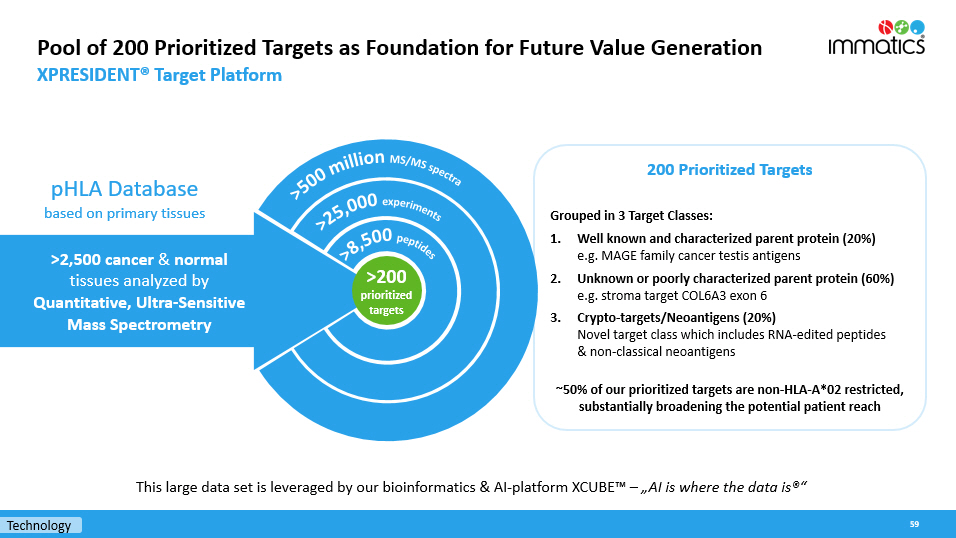
Well known and characterized parent protein (20%) e.g. MAGE family cancer testis antigens 2. Unknown or poorly characterized parent protein (60%) e.g. stroma target COL6A3 exon 6 3. Crypto - targets/Neoantigens (20%) Novel target class which includes RNA - edited peptides & non - classical neoantigens ~50% of our prioritized targets are non - HLA - A*02 restricted, substantially broadening the potential patient reach >2,500 cancer & normal tissues a nalyzed by Quantitative, Ultra - Sensitive Mass Spectrometry pHLA Database based on primary tissues >200 prioritized targets This large data set is leveraged by our bioinformatics & AI - platform XCUBE Ρ – „AI is where the data is ®“ Immatics ’ Unique Capability – Identification of the most Relevant Target Example of MAGEA4/8 Peptide Target 60 1 Copy number per tumor cell (CpC) measured on a paired - sample basis by AbsQuant®, i.e. comparing MAGEA4 vs. MAGEA4/A8 peptide pre sentation on same sample, 2 Students paired T test p<0.001 2 Technology MAGEA4/8 target is presented at >5 - fold higher target density 1 than a commonly targeted MAGEA4 target peptide XPRESIDENT® quantitative information on target density 1 between peptides originating from the same source protein Ranking of pHLA targets Commonly targeted
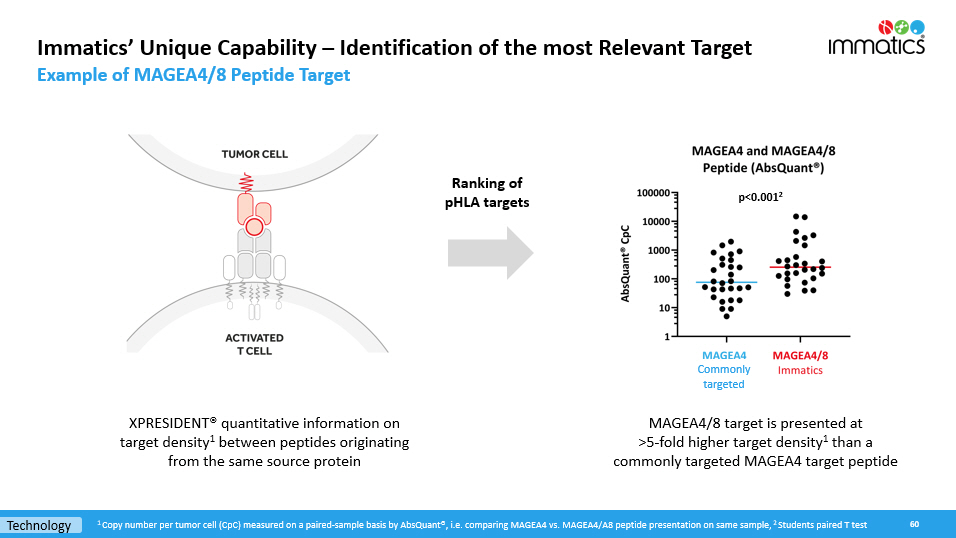
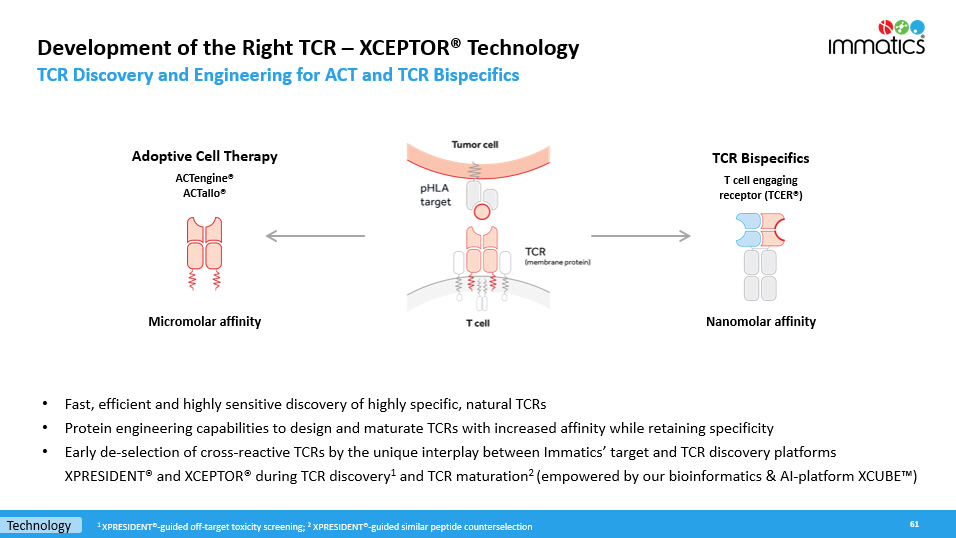
Development of the Right TCR – XCEPTOR® Technology TCR Discovery and Engineering for ACT and TCR Bispecifics 61 TCR Bispecifics T cell engaging receptor (TCER®) Adoptive Cell Therapy ACTengine® ACTallo ® • Fast, efficient and highly sensitive discovery of highly specific, natural TCRs • Protein engineering capabilities to design and maturate TCRs with increased affinity while retaining specificity • Early de - selection of cross - reactive TCRs by the u nique interplay between Immatics’ target and TCR discovery platforms XPRESIDENT® and XCEPTOR® during TCR discovery 1 and TCR maturation 2 (empowered by our bioinformatics & AI - platform XCUBE Ρ ) Micromolar affinity Nanomolar affinity Technology 1 XPRESIDENT® - guided off - target toxicity screening; 2 XPRESIDENT® - guided similar peptide counterselection Optimal Target Selection & TCR Specificity for Minimizing Safety Risks Unique Interplay between Technology Platforms Allows Early De - risking for Clinical Development 62 Target peptide presented on tumor cells Selective killing of tumor cells Target peptide presented on normal cells Off - target toxicity On - target (off - tumor) toxicity A different HLA is recognized on normal cells Alloreactivity Similar peptide presented on normal cells 1 XPRESIDENT® - guided screening for on - and off - target toxicities of TCRs based on the extensive database of peptides presented on normal tissues Technology 1 Clinical fatalities have occurred in TCR - T trials using a titin cross - reactive TCR (Cameron et al ., Sci Transl Med)

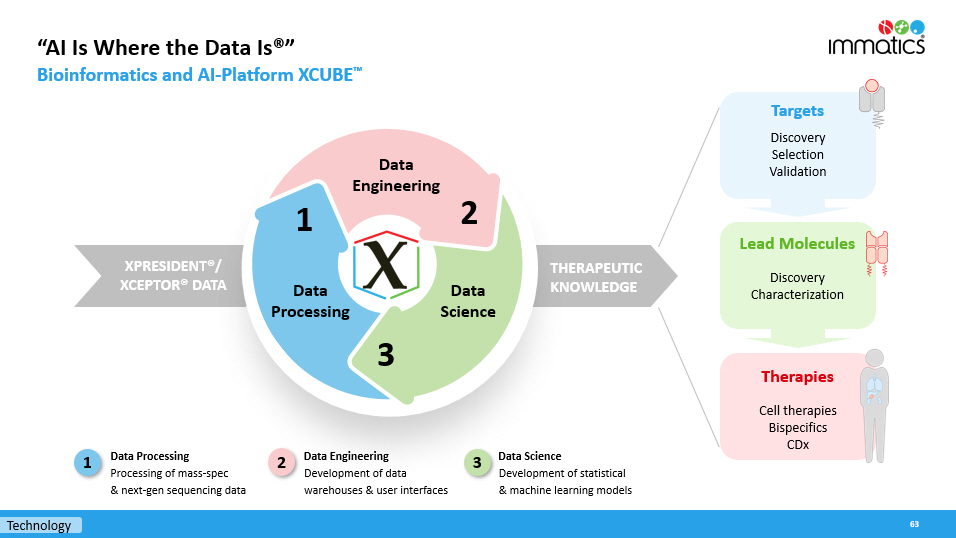
“AI Is Where the Data Is®” Bioinformatics and AI - Platform XCUBE Ρ 63 Data Engineering Development of data warehouses & user interfaces Data Science Development of statistical & machine learning models Data Processing Processing of mass - spec & next - gen sequencing data 1 THERAPEUTIC KNOWLEDGE XPRESIDENT®/ XCEPTOR® DATA Data Engineering Data Science Data Processing 2 3 1 Cell therapies Bispecifics CDx Therapies Targets Lead Molecules Discovery Characterization Discovery Selection Validation 2 3 Technology Immatics ’ Robust Intellectual Property Portfolio Protection Strategy of Key Assets in Major Markets and Beyond 64 Technologies Targets TCRs TCER® Therapeutic Uses Cell Therapy TCRs with high affinity and specificity profile Differentiated technologies, platforms and assays for Target Research, TCR and TCER® development >200 prioritized pHLA targets Half - life extended Bispecifics with proprietary TCER® format Treatment of indications and patient groups Clinical ACTengine® and TCER® candidates: IMA203, IMA203CD8, IMA402, IMA401 Clinical Candidates ACTengine® manufacturing & off - the - shelf ACTallo® platform


Corporate Information & Milestones 65

David Leitner Schuldirektor David Leitner Schuldirektor David Leitner Schuldirektor Harpreet Singh Chief Executive Officer Co - Founder >20 yrs biotech experience Arnd Christ Chief Financial Officer >20 yrs biotech experience ( InflaRx , Medigene , NovImmune , Probiodrug ) Carsten Reinhardt Chief Development Officer >20 yrs pharma & biotech experience ( Micromet , Roche, Fresenius) Cedrik Britten Chief Medical Officer >15 yrs pharma & biotech experience (GSK, BioNTech) Rainer Kramer Chief Business Officer >25 yrs pharma & biotech experience (Amgen, MorphoSys , Jerini , Shire, Signature Dx) Steffen Walter Chief Operating Officer Co - Founder Immatics US >15 yrs biotech experience Edward Sturchio General Counsel >15 yrs pharma & biotech experience ( Abeona Therapeutics, AAA, Novartis, Merck, Schering) ) Jordan Silverstein Head of Strategy >10 yrs biotech experience ( InflaRx , AAA) Toni Weinschenk Chief Innovation Officer Co - Founder >15 yrs biotech experience Experienced Global Leadership Team Across Europe and the US Corporate 66 Strong, Focused and Highly Integrated Trans - Atlantic Organization 67 Houston, Texas ~ 190 FTEs Cell therapy development & manufacturing Munich, Germany ~70 FTEs Various operating functions Tübingen, Germany ~ 225 FTEs Target & TCR discovery and TCR Bispecifics developme nt Corporate
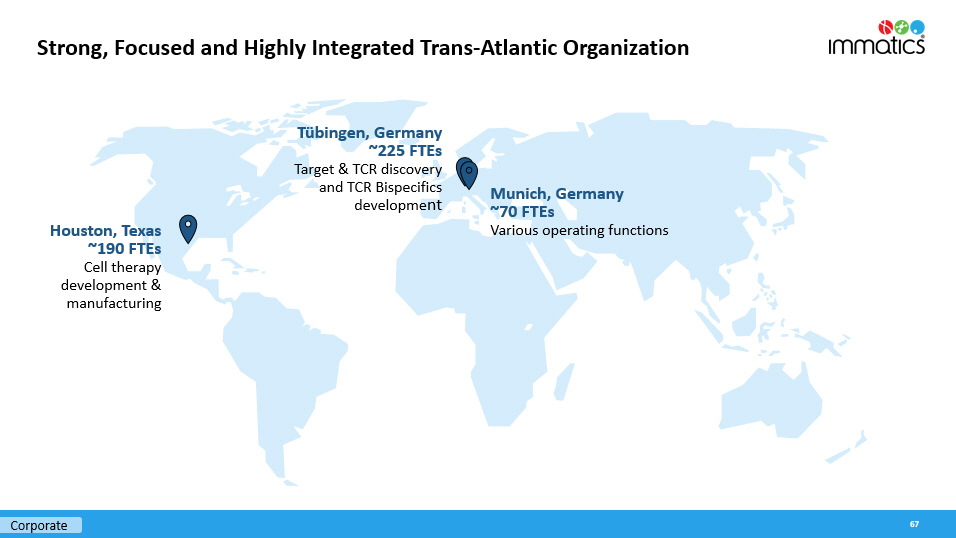

Delivering s the Power of T cells to Cancer Patients © Immatics. Not for further reproduction or distribution.
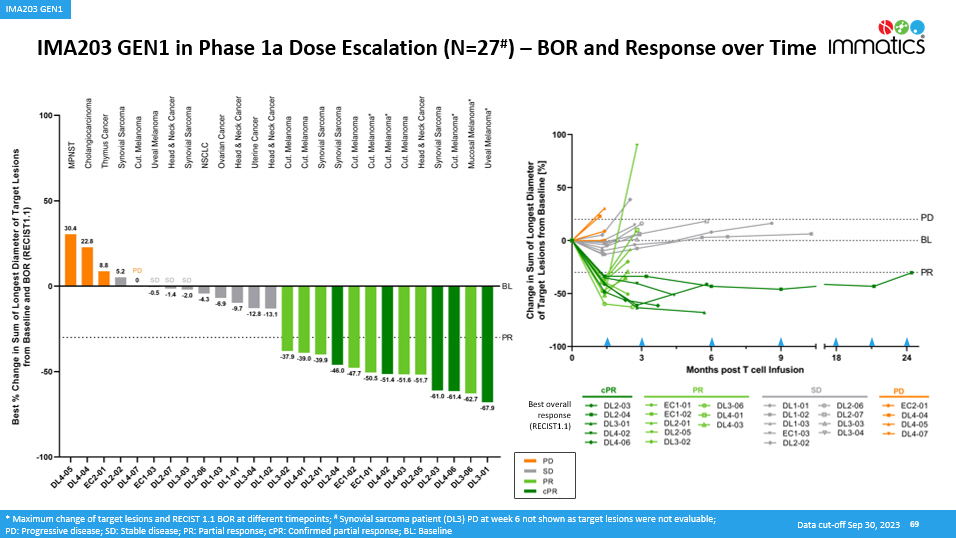

www.immatics.com Appendix IMA203 GEN1 in Phase 1a Dose Escalation (N=27 # ) – BOR and Response over Time 69 * Maximum change of target lesions and RECIST 1.1 BOR at different timepoints ; # Synovial sarcoma patient (DL3) PD at week 6 not shown as t arget lesions were not evaluable; PD: Progressive disease; SD: Stable disease; PR: Partial response; cPR : Confirmed partial response; BL: Baseline Best overall response (RECIST1.1) Data cut - off Sep 30, 2023 IMA203 GEN1 * IMA203 GEN1 in Cohort A (N=18) – BOR and Response over Time Objective Responses across Multiple Solid Cancer T ypes 70 1 Patient received one dose nivolumab erroneously; 2 Progressive disease at month 6 due to unequivocal progression of non - target lesions, target lesions not evaluable due to externa l assessment ; Initial ORR: Objective response rate according to RECIST 1.1 at any post infusion scan; Confirmed ORR ( cORR ): Confirmed objective response rate according to RECIST 1.1 for patients with at least two available post infusion scans or pat ients with progressive disease (PD) at any prior timepoint, patients with ongoing unconfirmed PR not included in cORR calculation; Duration of response (DOR) in confirmed responders is defined as time from first documented response until disease progressio n/d eath. Patients with ongoing response will be censored at date of data cut - off.
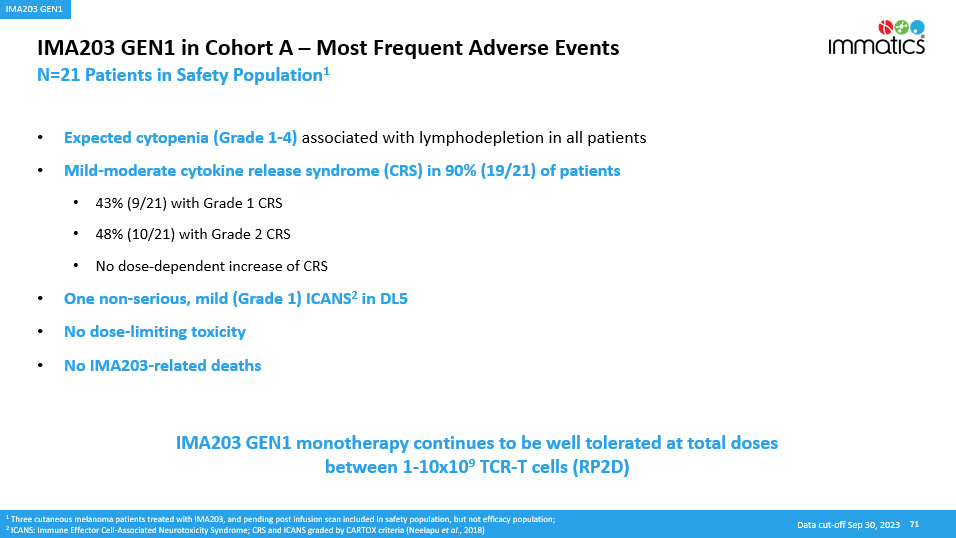
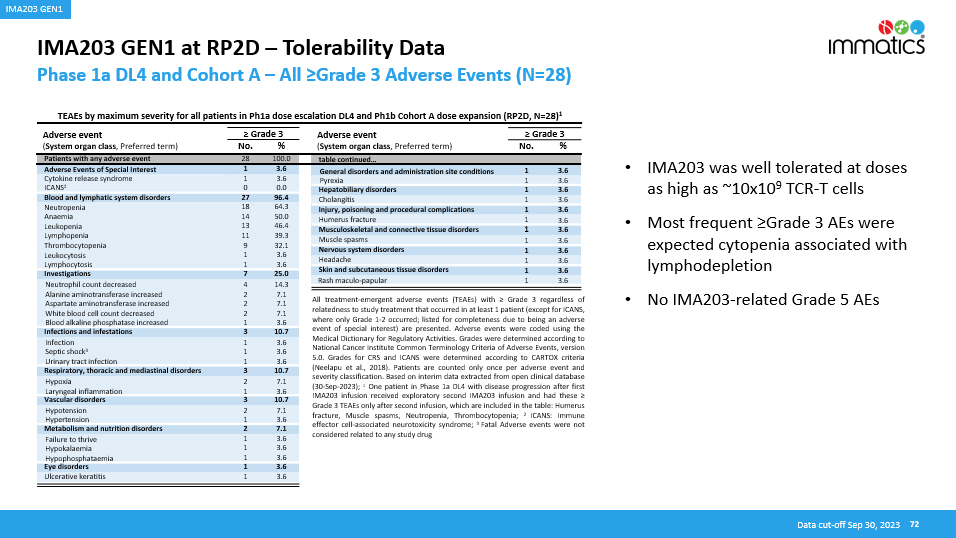
Median DOR is analyzed by using the Kaplan - Meier method; Median Follow - up is analyzed by using the reverse Kaplan - Meier method; PD: Progressive Disease; SD: Stable Disease; PR: Partial Response; cPR : Confirmed Partial Response; BL: Baseline; BOR: Best Overall Response; DOR: Duration of Response Data cut - off Sep 30, 2023 Median DOR, min, max DOR Not reached, 2.2+, 14.7+ months Median Follow - up 10.8 months Scans at approximately week 6, month 3 and then every 3 months Ongoing ORR 50% (9/18) cORR 47% (8/17) * Response until 5.7 months post infusion, target lesion response assessment not available (external assessment) IMA203 GEN1 71 Data cut - off Sep 30, 2023 IMA203 GEN1 in Cohort A – Most Frequent Adverse Events N=21 Patients in Safety Population 1 • Expected cytopenia (Grade 1 - 4) associated with lymphodepletion in all patients • Mild - moderate cytokine release syndrome (CRS) in 90% (19/21) of patients • 43% (9/21) with Grade 1 CRS • 48% (10/21) with Grade 2 CRS • No dose - dependent increase of CRS • O ne non - serious, mild (Grade 1) ICANS 2 in DL5 • No dose - limiting toxicity • No IMA203 - related deaths 1 Three cutaneous melanoma patients treated with IMA203, and pending post infusion scan included in safety population, but not ef ficacy population; 2 I CANS: Immune Effector Cell - Associated N eurotoxicity S yndrome ; CRS and ICANS graded by CARTOX criteria ( Neelapu et al ., 2018) IMA203 GEN1 monotherapy continues to be well tolerated at total doses between 1 - 10x10 9 TCR - T cells (RP2D) IMA203 GEN1 IMA203 GEN1 at RP2D – Tolerability Data Phase 1a DL4 and Cohort A – All ≥Grade 3 Adverse Events (N=28) 72 • IMA203 was well tolerated at doses as high as ~10x10 9 TCR - T cells • Most frequent ≥Grade 3 AEs were expected cytopenia associated with lymphodepletion • No IMA203 - related Grade 5 AEs All treatment - emergent adverse events (TEAEs) with ≥ Grade 3 regardless of relatedness to study treatment that occurred in at least 1 patient (except for ICANS, where only Grade 1 - 2 occurred ; listed for completeness due to being an adverse event of special interest) are presented . Adverse events were coded using the Medical Dictionary for Regulatory Activities . Grades were determined according to National Cancer Institute Common Terminology Criteria of Adverse Events, version 5 . 0 . Grades for CRS and ICANS were determined according to CARTOX criteria ( Neelapu et al . , 2018 ) . Patients are counted only once per adverse event and severity classification . Based on interim data extracted from open clinical database ( 30 - Sep - 2023 ) ; 1 One patient in Phase 1 a DL 4 with disease progression after first IMA 203 infusion received exploratory second IMA 203 infusion and had these ≥ Grade 3 TEAEs only after second infusion, which are included in the table : Humerus fracture, Muscle spasms, Neutropenia, Thrombocytopenia ; 2 ICANS : Immune effector cell - associated neurotoxicity syndrome ; 3 Fatal Adverse events were not considered related to any study drug Adverse event ( System organ class , Preferred term ) ≥ Grade 3 No . % Patients with any adverse event 28 100.0 Adverse Events of Special Interest 1 3.6 Cytokine release syndrome 1 3.6 ICANS 2 0 0.0 Blood and lymphatic system disorders 27 96.4 Neutropenia 18 64.3 Anaemia 14 50.0 Leukopenia 13 46.4 Lymphopenia 11 39.3 Thrombocytopenia 9 32.1 Leukocytosis 1 3.6 Lymphocytosis 1 3.6 Investigations 7 25.0 Neutrophil count decreased 4 14.3 Alanine aminotransferase increased 2 7.1 Aspartate aminotransferase increased 2 7.1 White blood cell count decreased 2 7.1 Blood alkaline phosphatase increased 1 3.6 Infections and infestations 3 10.7 Infection 1 3.6 Septic shock 3 1 3.6 Urinary tract infection 1 3.6 Respiratory, thoracic and mediastinal disorders 3 10.7 Hypoxia 2 7.1 Laryngeal inflammation 1 3.6 Vascular disorders 3 10.7 Hypotension 2 7.1 Hypertension 1 3.6 Metabolism and nutrition disorders 2 7.1 Failure to thrive 1 3.6 Hypokalaemia 1 3.6 Hypophosphataemia 1 3.6 Eye disorders 1 3.6 Ulcerative keratitis 1 3.6 Adverse event ( System organ class , Preferred term ) ≥ Grade 3 No . % table continued… General disorders and administration site conditions 1 3.6 Pyrexia 1 3.6 Hepatobiliary disorders 1 3.6 Cholangitis 1 3.6 Injury, poisoning and procedural complications 1 3.6 Humerus fracture 1 3.6 Musculoskeletal and connective tissue disorders 1 3.6 Muscle spasms 1 3.6 Nervous system disorders 1 3.6 Headache 1 3.6 Skin and subcutaneous tissue disorders 1 3.6 Rash maculo - papular 1 3.6 TEAEs by maximum severity for all patients in Ph1a dose escalation DL4 and Ph1b Cohort A dose expansion ( RP2D, N=28) 1 Data cut - off Sep 30, 2023 IMA203 GEN1 Delivering s the Power of T cells to Cancer Patients © Immatics.

Not for further reproduction or distribution. www.immatics.com